Samsung S90F is an excellent representative of the premium mid-range in the world of OLED TVs. We have an organic matrix here that guarantees perfect contrast – and no matter how much LCD manufacturers try with local dimming in Mini LEDs, this black simply cannot be replicated. The S90F shows its class without any compromises. Compared to last year's model, we get a slightly brighter WOLED panel, which in favourable conditions can reach up to 1200 nits. This is a result that suffices for comfortable viewing of HDR materials in most scenes at reference quality – especially on streaming platforms such as Netflix. The picture quality here is very high, regardless of whether we are watching a movie, playing on a console, or streaming a sports broadcast. By the way – versatility is one of the biggest advantages of this model. With 144 Hz refresh rate, very low input lag, and a full package of gaming features (including functional HGiG and the unique Game Motion Plus motion smoother), it's hard to complain about anything here. The Tizen system performed really well on the S90F. It has its limitations – primarily the closed ecosystem and a smaller selection of apps than Google TV – but if you mainly use the most popular services, this shouldn't be an issue. A big plus is also the remote, which can operate most connected devices – even despite the lack of a numeric keypad. There are downsides too. The built-in media player has issues with some formats, and the anti-reflective coating typical of WOLEDs doesn’t handle strong light very well – reflections can be noticeable. We also do not have support for DTS and Dolby Vision, but this is a standard at Samsung that's been expected for years. So is the S90F with a WOLED panel the perfect TV? No – but it really is very close. It is one of the most polished and complete OLEDs in this price range, which can easily handle any content, from a series on Netflix, to console gaming, to a Sunday match.
- Matching (Score)
- Our verdict
- TV appearance
- Where to buy
- Contrast and black detail
- HDR effect quality
- Factory color reproduction
- Color reproduction after calibration
- Smoothness of tonal transitions
- Image scaling and smoothness of tonal transitions
- Blur and motion smoothness
- Console compatibility and gaming features
- Input lag
- Compatibility with PC
- Viewing angles
- TV efficiency during daytime
- Details about the matrix
- TV features
- Apps
- Playing files from USB
- Sound
SAMSUNG S90F (WOLED) vs Hisense U8Q
Direct compare
S90FAE
U8Q
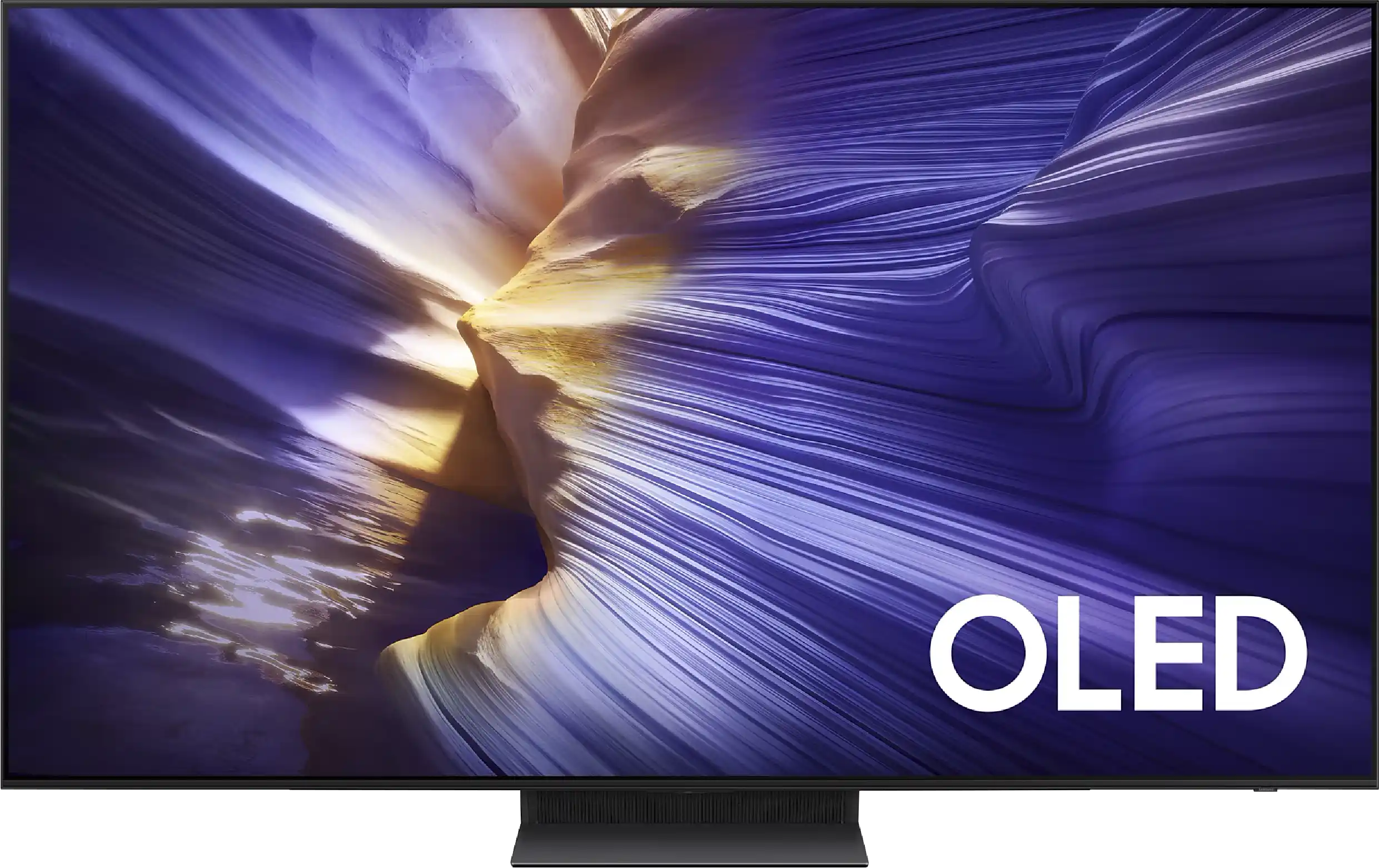
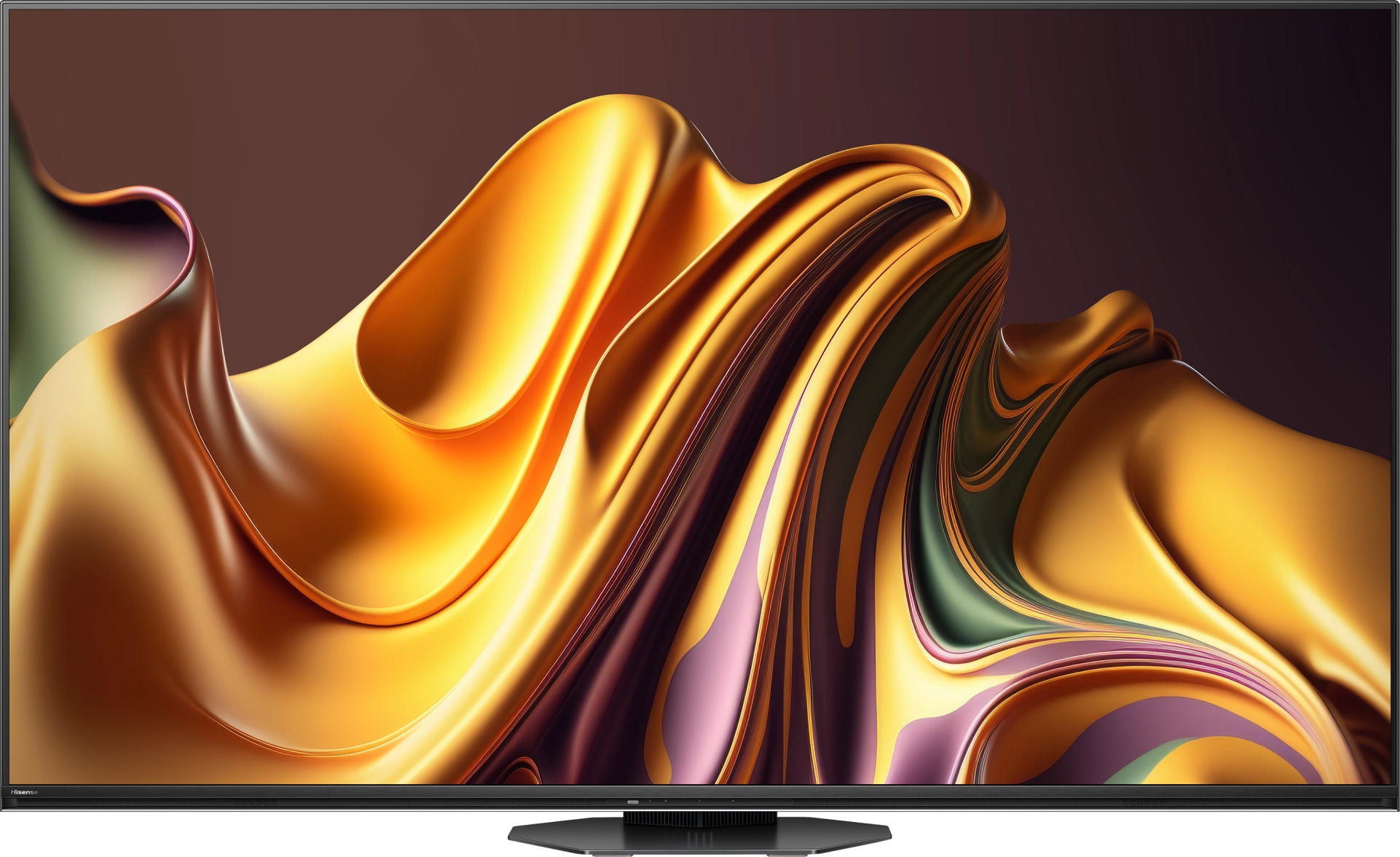
Panel type: WRGB OLED
Resolution: 3840x2160
System: Tizen
Model year: 2025
Complete the survey to find out the result

Panel type: LCD VA
Resolution: 3840x2160
System: VIDAA
Model year: 2025
Complete the survey to find out the result

Overall rating
8.1
8.0
Movies and series in UHD quality
8.3
7.8
Classic TV, YouTube
8.7
7.6
Sports broadcasts (TV and apps)
8.5
7.2
Gaming on console
9.6
8.6
TV as a computer monitor
8.6
8.4
Watching in bright light
6.1
8.2
Utility functions
7.2
9.4
Apps
8.7
7.7
Sound quality
7.4
7.8
Complete the survey to find out what fits your preferences
Advantages
Stunning black and contrast
High brightness for an OLED TV - 1200 nits peak brightness
Very good motion smoothness - 144Hz OLED display
Low latency - input lag 5ms
Gaming features: 4x HDMI 2.1, VRR, ALLM, Game Motion Plus, etc.
PiP function and great support for external devices with solar remote control
Expanded operating system: Tizen
Pleasant sound with slightly noticeable bass
Great blacks and contrast
Incredibly high brightness
Full package of HDR formats: HDR10, HDR10+, Dolby Vision
Good motion smoothness - 165Hz panel
Exceptional usability in difficult lighting conditions (High brightness + New anti-reflective coating on the panel)
Many features for gamers, VRR, ALLM, HDMI 2.1, 288Hz for PC
All 3 ports in HDMI 2.1 standard (Finally!)
USB-C with video signal output capability (Displayport)
Many features in the Vidaa system
Support for DTS and Dolby Atmos
Disadvantages
Issues with playback of certain formats from USB.
Subtle degradation in tonal transitions (performs worse than the previous S90D)
Lack of support for DTS:X – an external amplifier is required for full support of this format
Missing some apps on the Vidaa operating system
At maximum volume, the television slightly shakes
The television tends to "burn out" the image in 4K HDR content.
Our verdict
Hisense U8Q is a television that makes it hard not to feel that the manufacturer approached the topic with the ambition of a top student. The picture is strong, vibrant, and contrasted – as if it’s shouting: “look, I can do more than most at this price!” And indeed, there is something to this. The secret lies in the large number of dimming zones in Mini-LED technology. Thanks to them, HDR doesn't just end with promises from the brochure, but can truly impress – especially during evening screenings. It's also hard to complain about motion smoothness. Watching matches and fast-paced games is enjoyable, and while the ball may leave a slight trail at times, it will be a negligible detail for 99% of viewers in everyday watching. Gamers also have reasons to be pleased here – although it should be mentioned right away that there is no HGiG feature. Other than that, it’s really good: low input lag, three HDMI 2.1 ports, and a full set of gaming features make the U8Q stand out as one of the more interesting Mini-LEDs for console fans. Of course, there are no perfect products. The television still carries some "miniLED" quirks, and the Vidaa system – although packed with features – can be less intuitive and has a more modest selection of apps compared to competing platforms. But are these serious flaws or rather minor drawbacks in the context of price and what we actually get? We leave that question for you to answer!
TV appearance
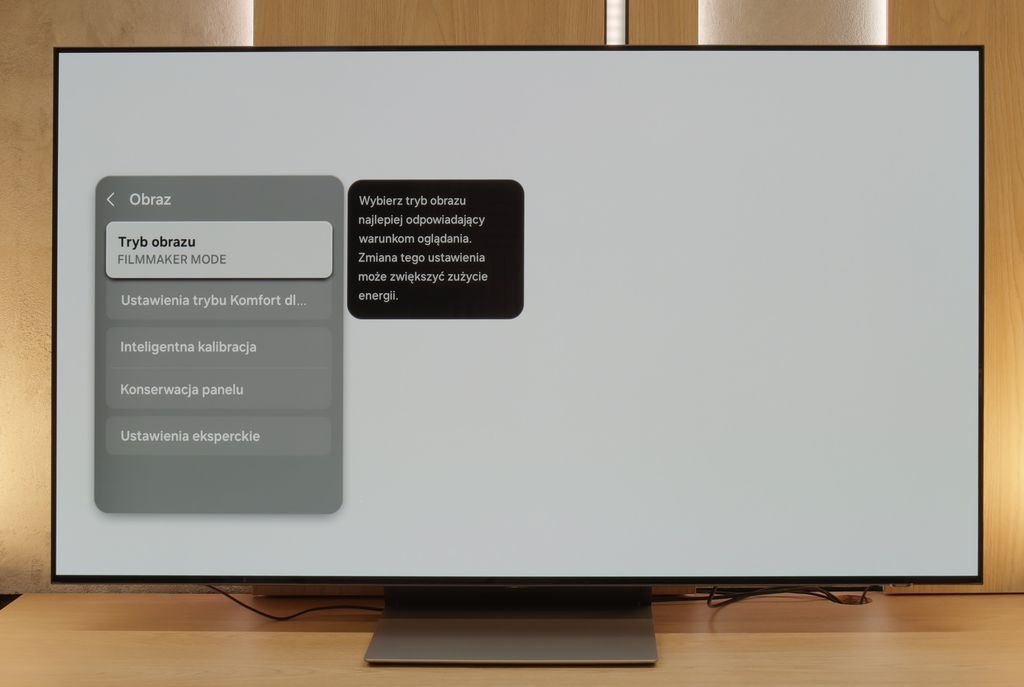
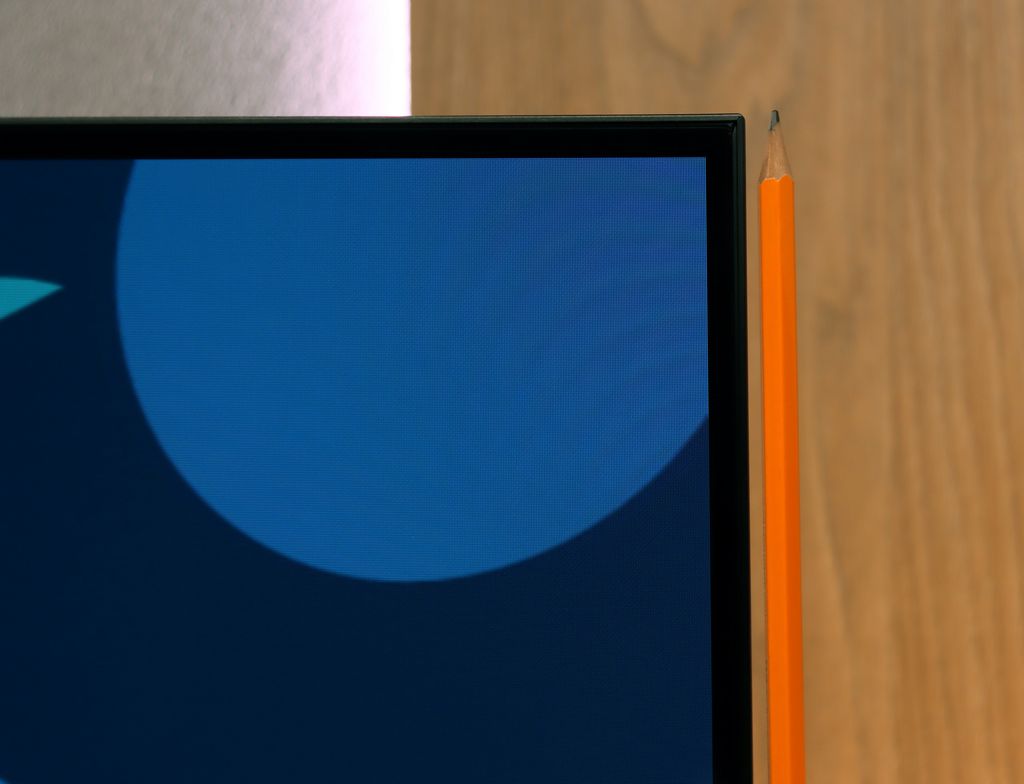
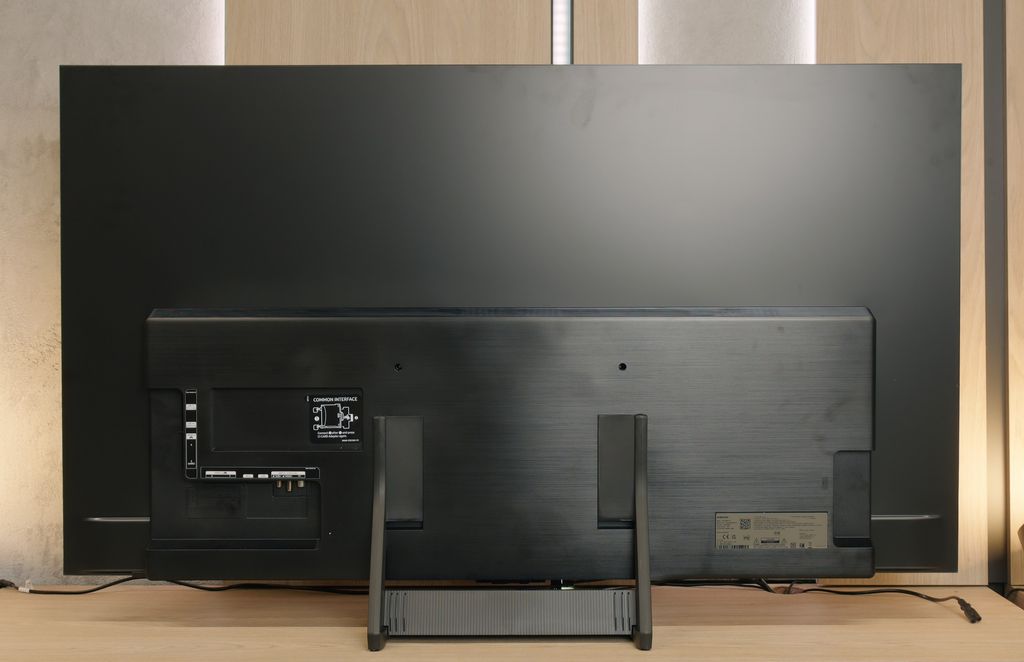
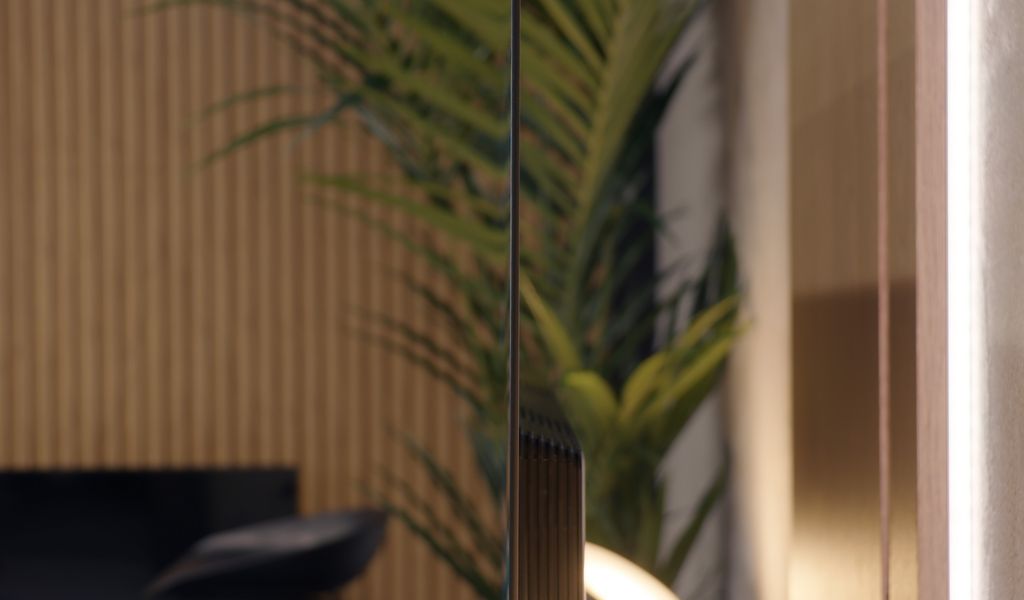
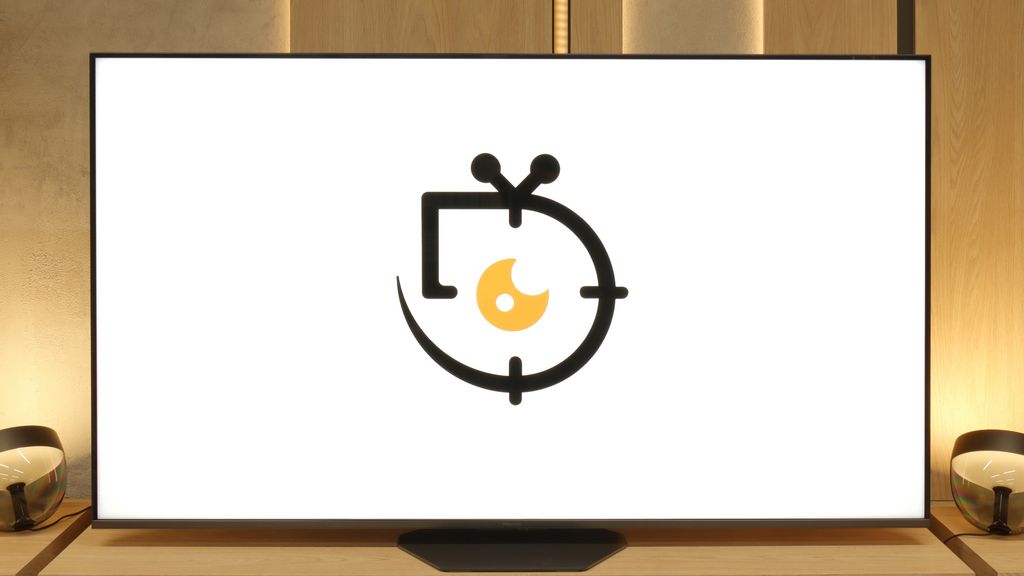
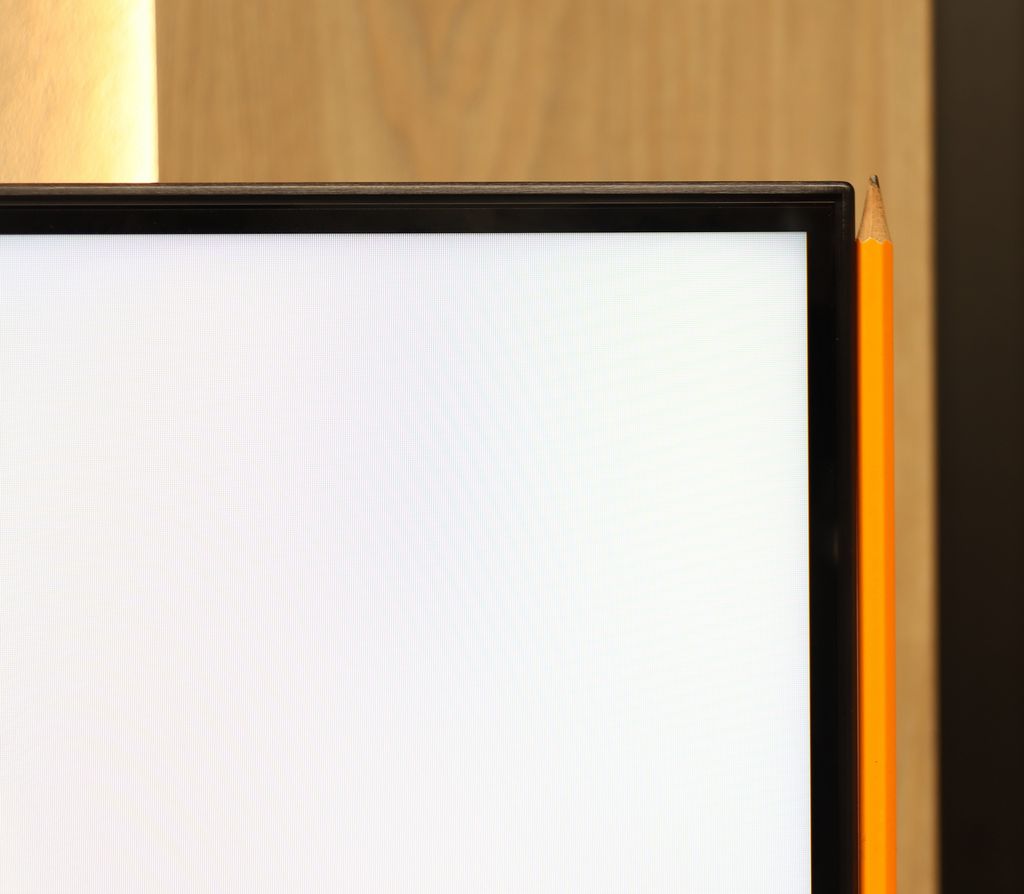
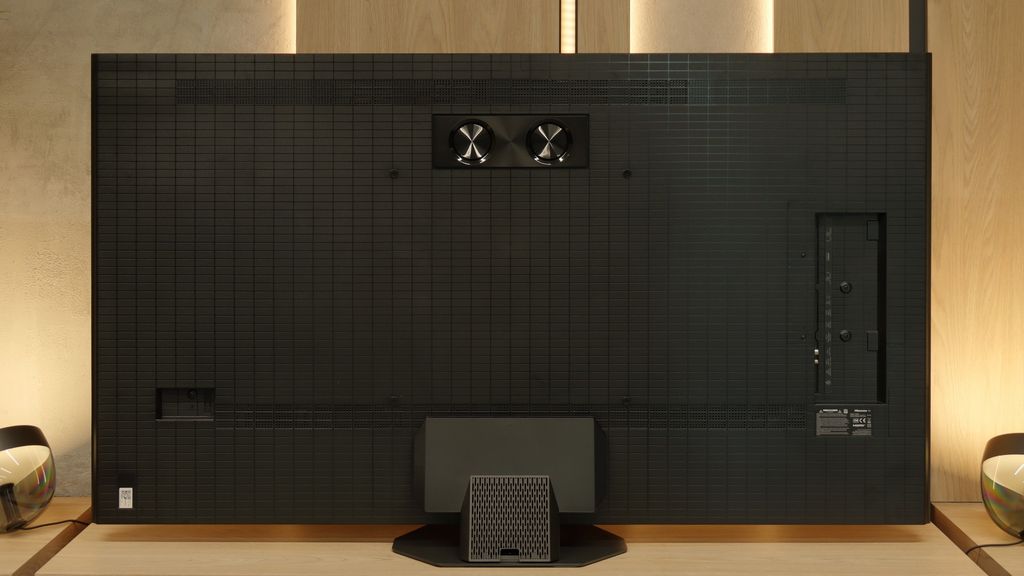
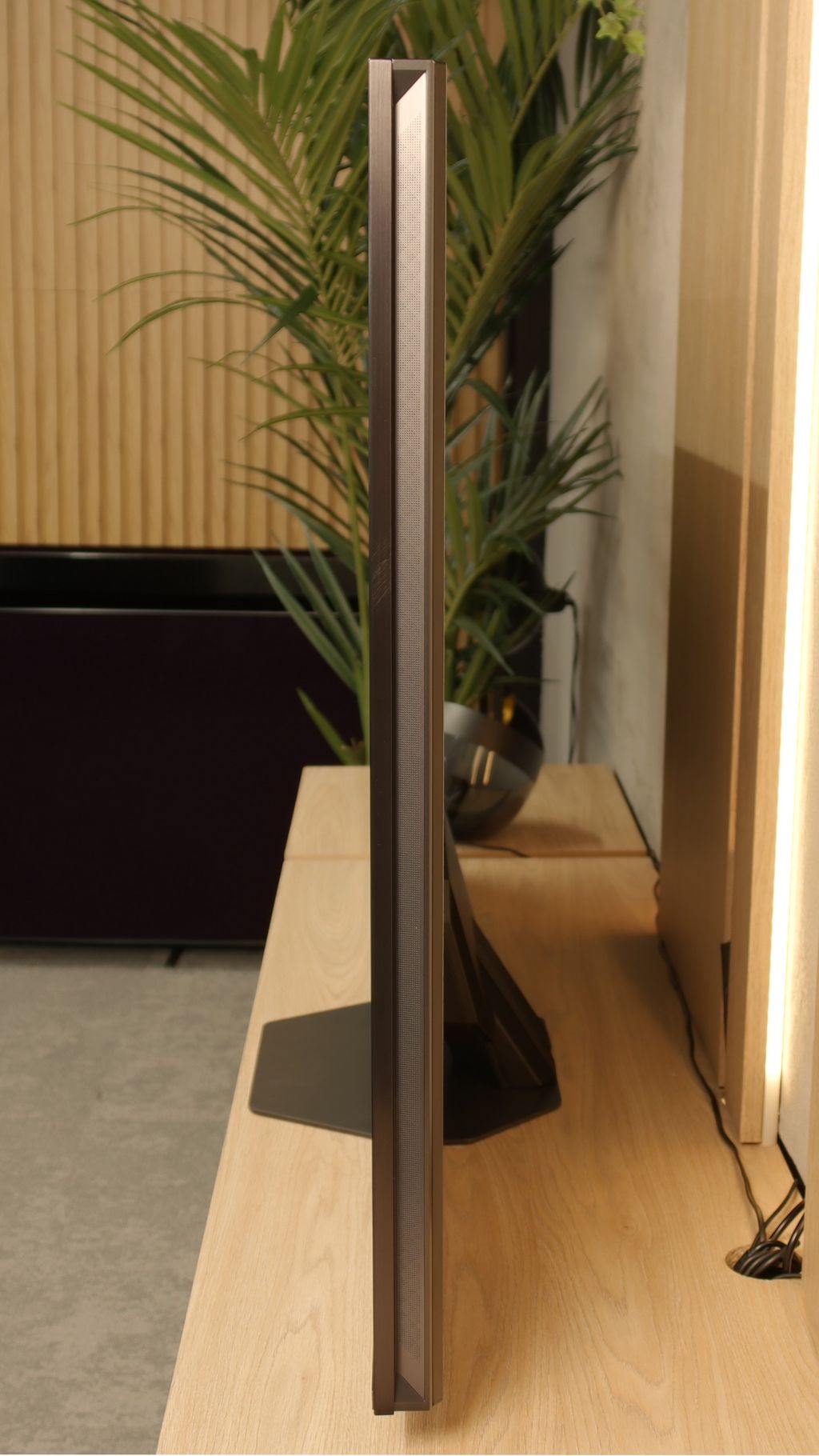
Contrast and black detail
10/10
8.6/10
Local dimming function: Yes, number of zones: 2048 (32 x 64)
Contrast:

Result
∞:1

Result
∞:1

Result
∞:1

Result
∞:1

Result
∞:1

Result
1,024,000:1

Result
140,000:1

Result
35,000:1

Result
22,350:1

Result
22,300:1
Halo effect and black detail visibility:
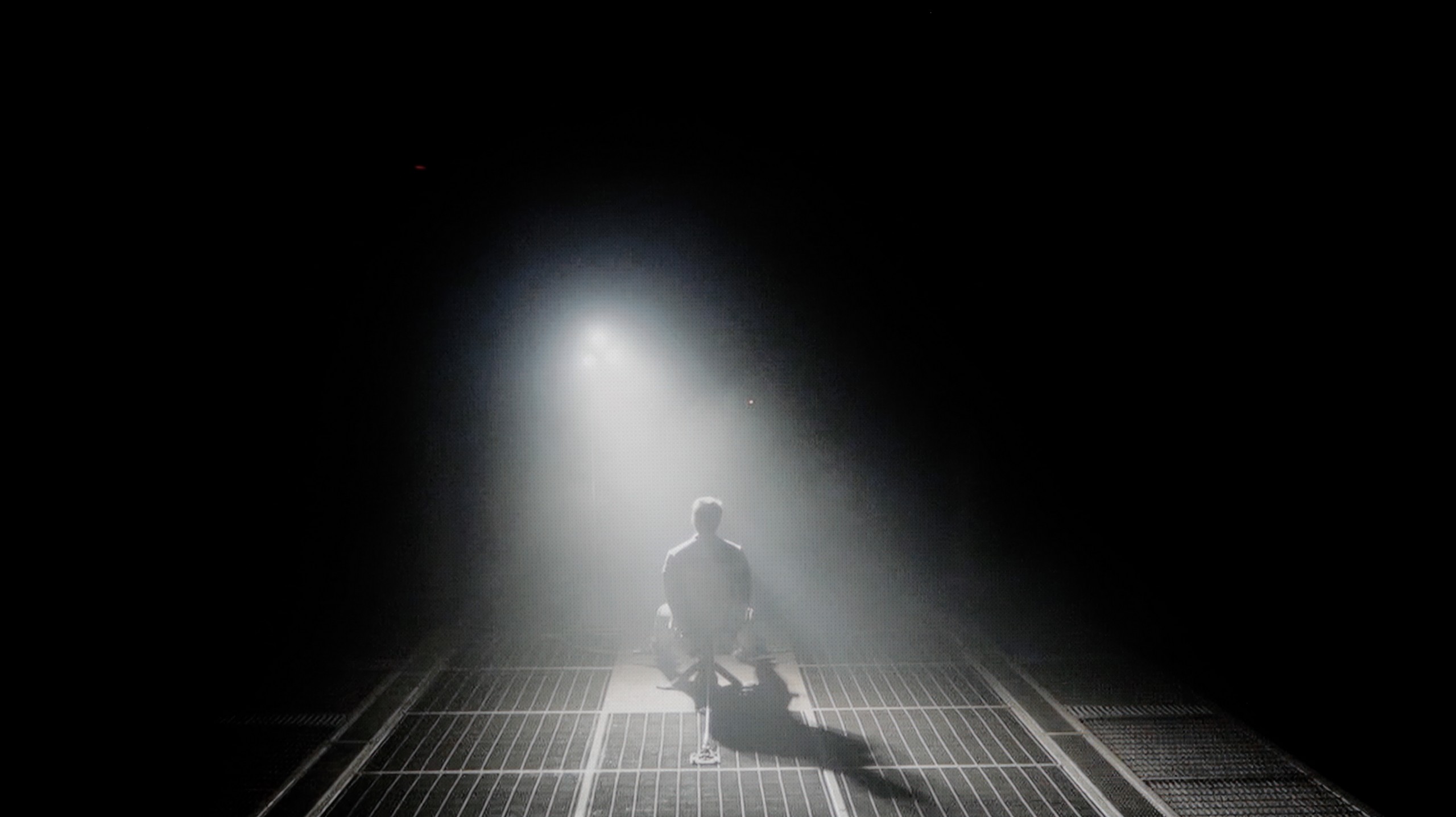

In the case of the Samsung S90F, we are dealing with an interesting situation: nearly all size variants have been equipped with WOLED panels, except for the 65-inch version, which received a QD-OLED panel. In this test, we analyse the version with the WOLED panel produced by LG Display, but the question remains; Does this affect the quality of black and contrast in this part of the test? In practice – it does not. Regardless of the technology used, both panels can produce perfect black and infinite contrast. This is exactly what we expect from any top-tier television. Watching a series in the evening, in a completely dark room, is sheer pleasure. The television easily separates bright elements – such as reflections or background lights – from the deep, dark parts of the image, without creating any halo or brightness issues that high-end LCD televisions still struggle with. This is where OLED technology shows its strength – and the S90F is no exception. When it comes to black and contrast, we can't fault it at all.
The unit we tested, the Hisense U8Q in 65 inches, is equipped with a VA panel that offers high native contrast on its own. However, this is not the biggest strength of this model—the key lies in the Mini LED backlighting. With the use of thousands of dimming zones and a well-tuned light management algorithm, the contrast in the U8Q can be described as excellent, especially for a TV of this technology.
The best results reach around a million to one—a result that is impressive and places the U8Q among the top Mini LED TVs. Yes, there are certain issues and even drops in contrast, but they are not as dramatic as with many other models in this class that we have tested on our portal. It's also worth noting that like every Mini LED TV, the U8Q is not completely free from typical imperfections—sometimes the picture can be dimmed too much, or there may be slight blooming effects with a halo. However, this does not change the overall impression: the contrast in the Hisense U8Q is stunning and is one of the greatest assets of this model.
HDR effect quality
7.2/10
7.6/10
Luminance measurements in HDR:

Result
1099 nit

Result
1177 nit

Result
1252 nit

Result
1183 nit

Result
577 nit

Result
2195 nit

Result
725 nit

Result
1652 nit

Result
485 nit

Result
1541 nit
Scene from the movie “Pan” (about 2800 nits)


Scene from the movie “Billy Lynn” (about 1100 nits)


Static HDR10


Dynamic: HDR10+
Dynamic: Dolby Vision


HDR luminance chart:
Hisense U8Q
Luminancja HDR
Luminance of RGB colors
SAMSUNG S90F (WOLED)
Luminancja HDR
Luminance of RGB colors
Does the S90F handle not only blacks but also bright parts of the image? Definitely. The stories about OLEDs as "dark screens" can slowly be regarded as myth. The Samsung S90F, like the LG C5 based on a very similar panel, achieves brightness exceeding 1000 nits. This is a value more than enough to enjoy impressive and dynamic HDR images – both in movies and series. Most of the scenes we tested look stunning, with well-defined highlights and high contrast. Of course, OLED technology still has its limitations – in very bright, full-screen sequences, such as the test card from the movie The Meg (photo 5), the television may noticeably dim the image. However, it should be emphasized that such scenes are rare. It can be said that the HDR effect is good enough that even mid-range OLED models like the S90F can provide a cinematic experience in the home living room.
When it comes to HDR, the Hisense U8Q shows its claws. On paper, meaning in synthetic measurement tests, the TV can "push out" nearly 4000 nits of peak brightness. This is a value that most models can only envy. In practice, this translates to very strong light effects in movies – in some scenes we managed to measure real levels from 1500 to 2000 nits, which is a level usually reserved for the absolute top-tier TVs on the market.
Of course, it's not always so perfect. In small, point-like elements, brightness can drop – a good example is scene number 4 from the movie Sicario 2, where instead of thousands of nits we get about 500. But it's worth noting that the effect doesn't disappear completely – the light is still visible, and the image doesn't appear artificially dimmed. This is a typical issue with Mini LEDs, so it’s hard to consider it a major drawback.
However, a huge plus has to be granted for colour reproduction. Thanks to additional coatings improving colour saturation, the U8Q almost covers the entire DCI-P3 colour space (98%), and for the wider BT.2020 gamut it achieved over 80%. This is an excellent result that makes HDR films look juicy, intense, and just very cinematic.
Factory color reproduction
7/10
7/10


Factory Mode
After calibration


Factory Mode
After calibration
Samsung S90F, like most modern televisions, offers many picture modes, but – following our testing tradition – we checked it out in the best one, which is the Filmmaker mode. Thanks to this, the image looks much more natural than in the default, often oversaturated settings. It was neither overly saturated nor artificially dimmed – simply closer to what one should see. Of course, “more accurate” doesn’t mean “perfect”. Unfortunately, our S90F had significant issues with white balance, particularly in the blue color range, resulting in a slightly yellowish filter being applied to most scenes. Someone might say it looks more “filmic” – because it’s warmer – but let’s not kid ourselves, George Lucas didn’t film Star Wars in sepia 😉 (you’ll find a comparison with the scene below as always).
Additionally, in HDR materials, there was an issue with brightness management. The EOTF curve showed a clear “spike” in brightness – the television brightened the image more than it should have, causing some effects to look too intense and deviating from the reference. Fortunately, some of these problems can be eliminated through professional calibration – you’ll read about its effects later in the review.
We have to admit that when the U8Q arrived in our editorial office, we were slightly surprised… and in a good way. Usually, white balance in televisions immediately requires adjustment – it can be too warm or too cold, which immediately causes strange colour errors. Meanwhile, here the situation looks really good straight out of the box. Of course, we’re talking about our unit, so there’s no guarantee that every model will be tuned as well, but in our case, the first impressions were very positive. The only more noticeable issue was related to how the television manages brightness. Looking at the EOTF chart, it’s clear that the U8Q tends to brighten small elements on the screen. This, in turn, caused what we mentioned earlier – slight overexposure and the impression that the whole scene is a bit too bright. However, this is not a flaw that negates the picture, rather an effect characteristic of this model.
Color reproduction after calibration
9.2/10
8/10

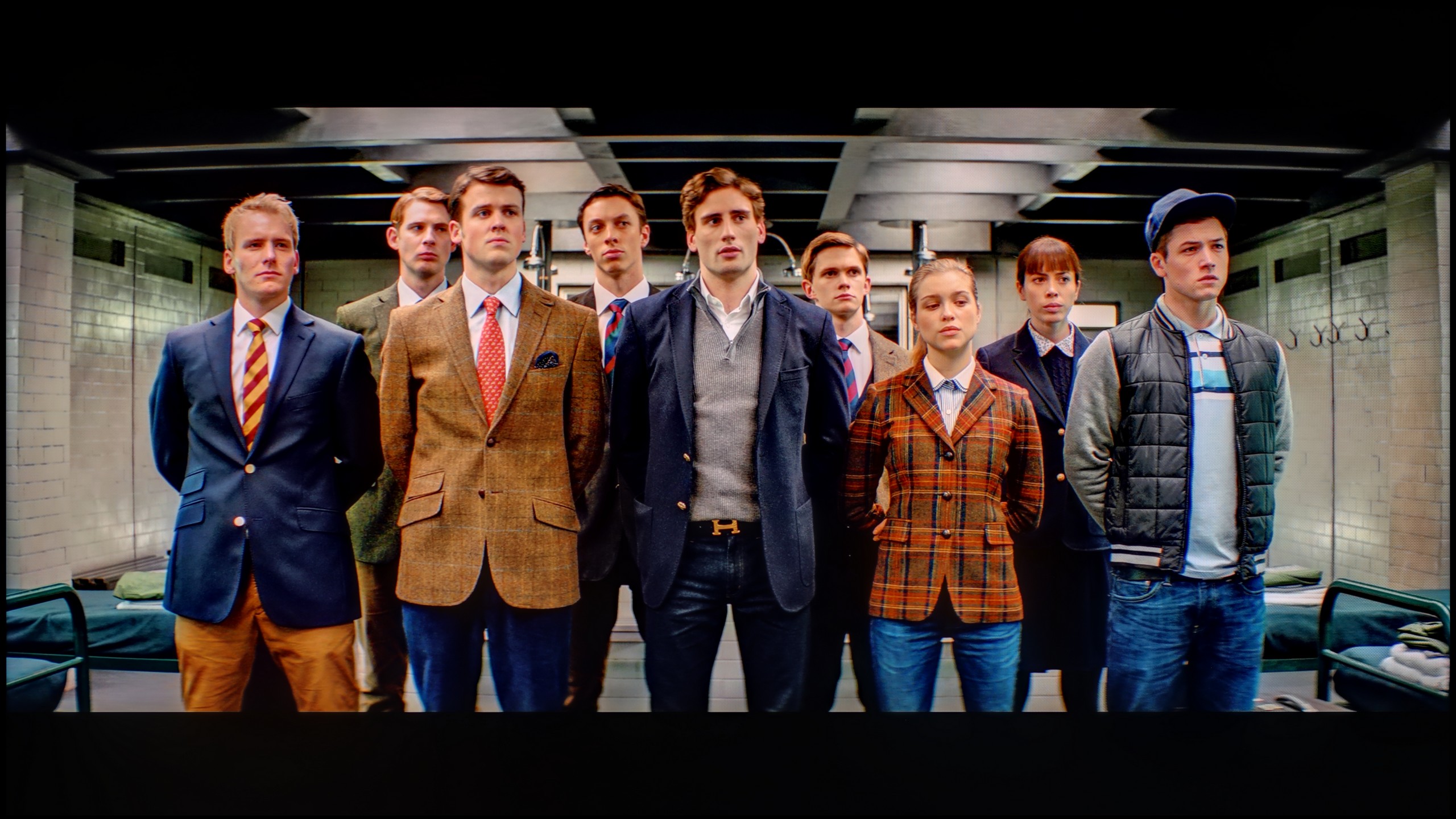


After calibration, we managed to eliminate practically all the previously mentioned errors. Older movies in SDR quality finally look like they should – without the sepia effect or artificial aging of the image. The atmosphere of the classics is back in place (no thanks needed, Star Wars fans), and the colours no longer resemble an Instagram filter.
One of the key changes was also the improvement of brightness characteristics in HDR content. We managed to control the EOTF curve in almost a reference manner. Admittedly, the most demanding users may detect minimal deviations in brightness, but honestly – most viewers won't even notice that. And it's no surprise because the vast majority of errors fall below the ΔE 3 value, which is below the threshold of visibility. After calibration, the S90F (WOLED) becomes a truly excellent display – one on which you can enjoy nearly perfect image quality.
Of course, we wouldn’t be ourselves if we didn’t make adjustments to the white balance. After calibration, we managed to level the SDR signal to near perfection – older films, YouTube content, and classic television looked nearly ideal on the U8Q. It’s truly an impressive level that shows this model can do a lot if given a bit of help. Unfortunately, the situation is different with HDR content. The colours themselves don’t pose much of a problem, but the biggest issue with the U8Q remains the EOTF brightness characteristics. In practice, the television tends to "shoot" above how the image should originally look. It’s this slight "blowout" we noticed earlier in comparisons with the best screens on the market. It’s a bit of a shame that this characteristic can't be completely tamed – if we could maintain equally good brightness control in HDR as we do in SDR, we would be looking at an absolutely reference-level image.
Smoothness of tonal transitions
7.3/10
8.9/10
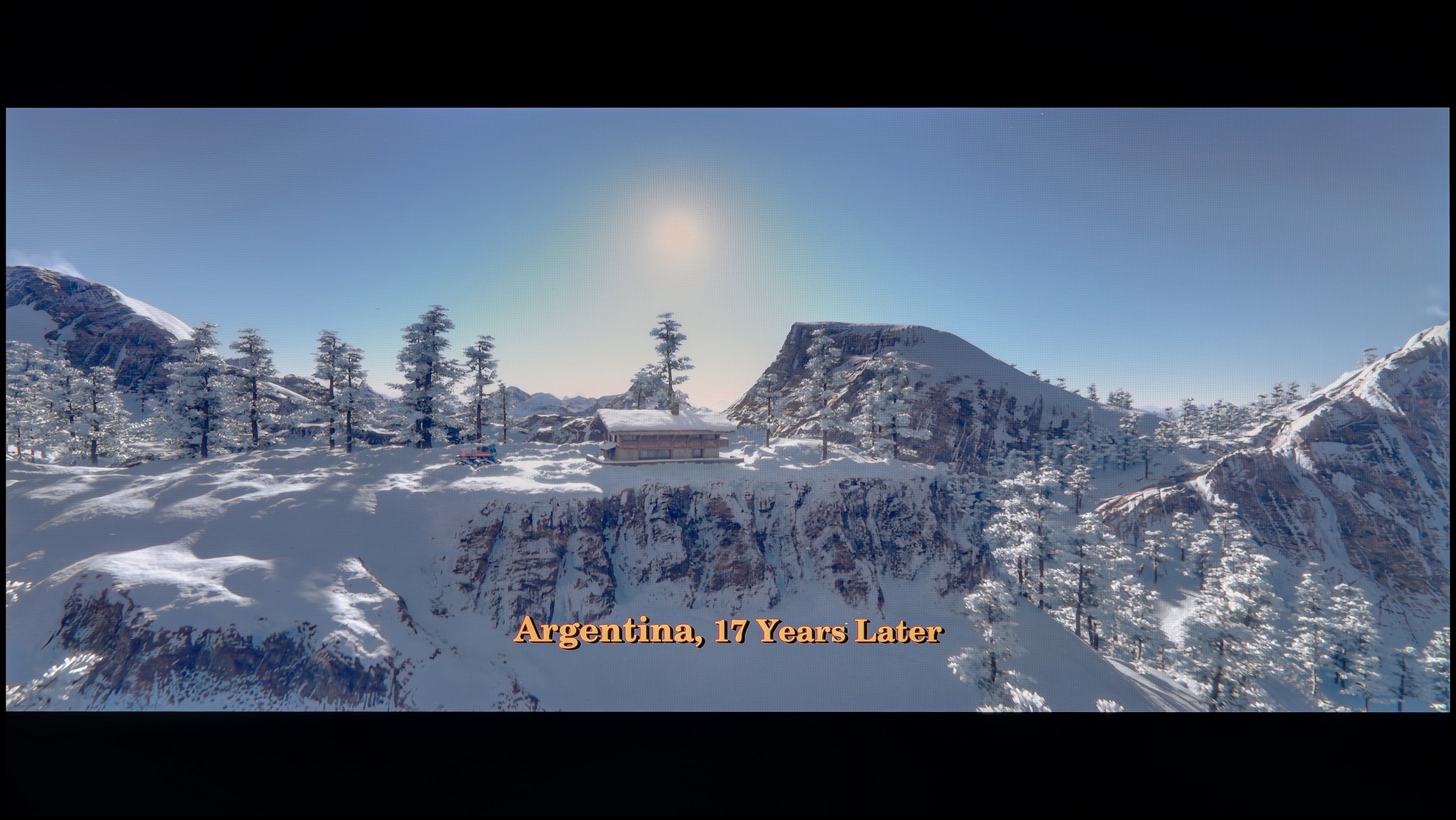




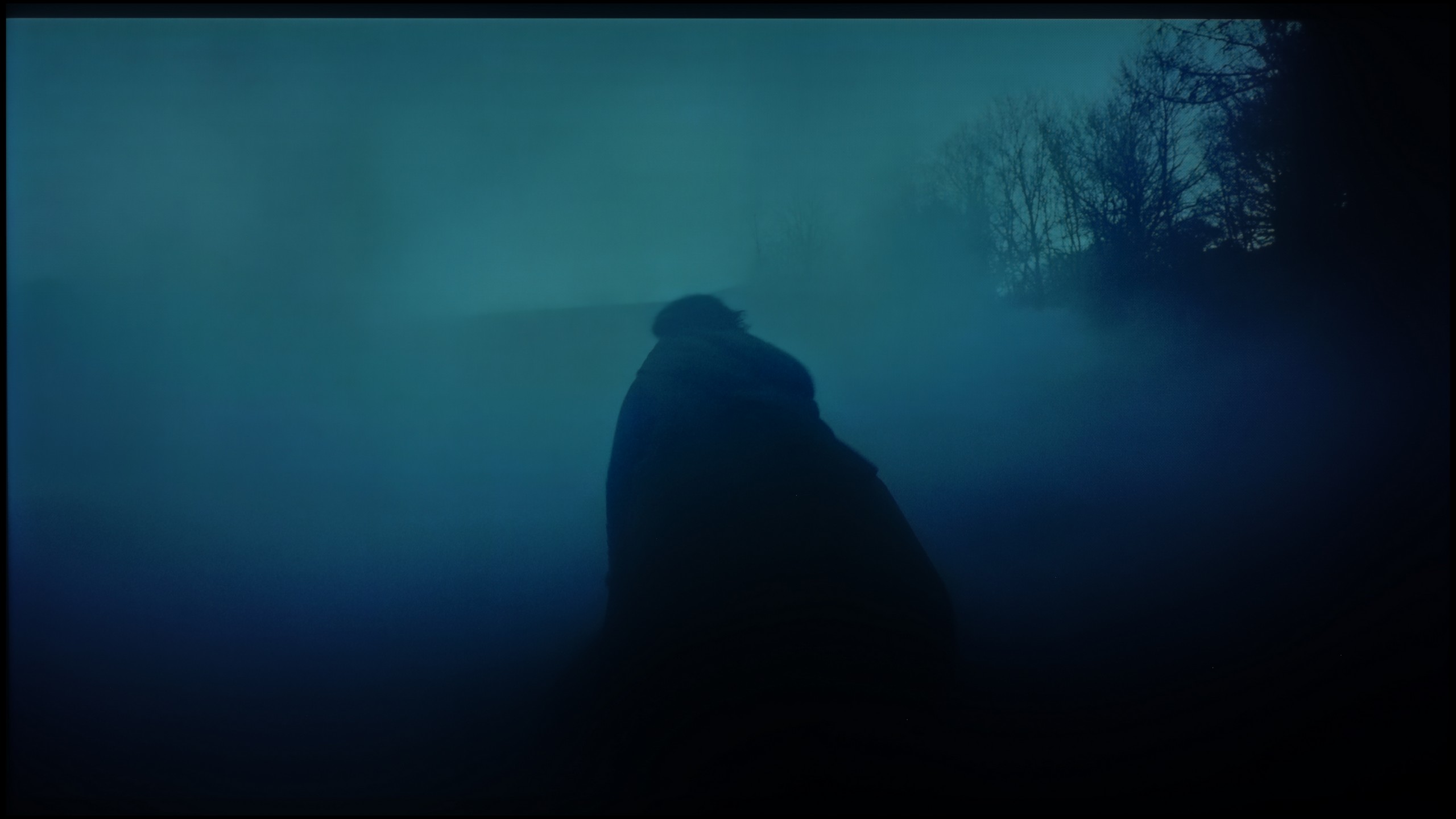

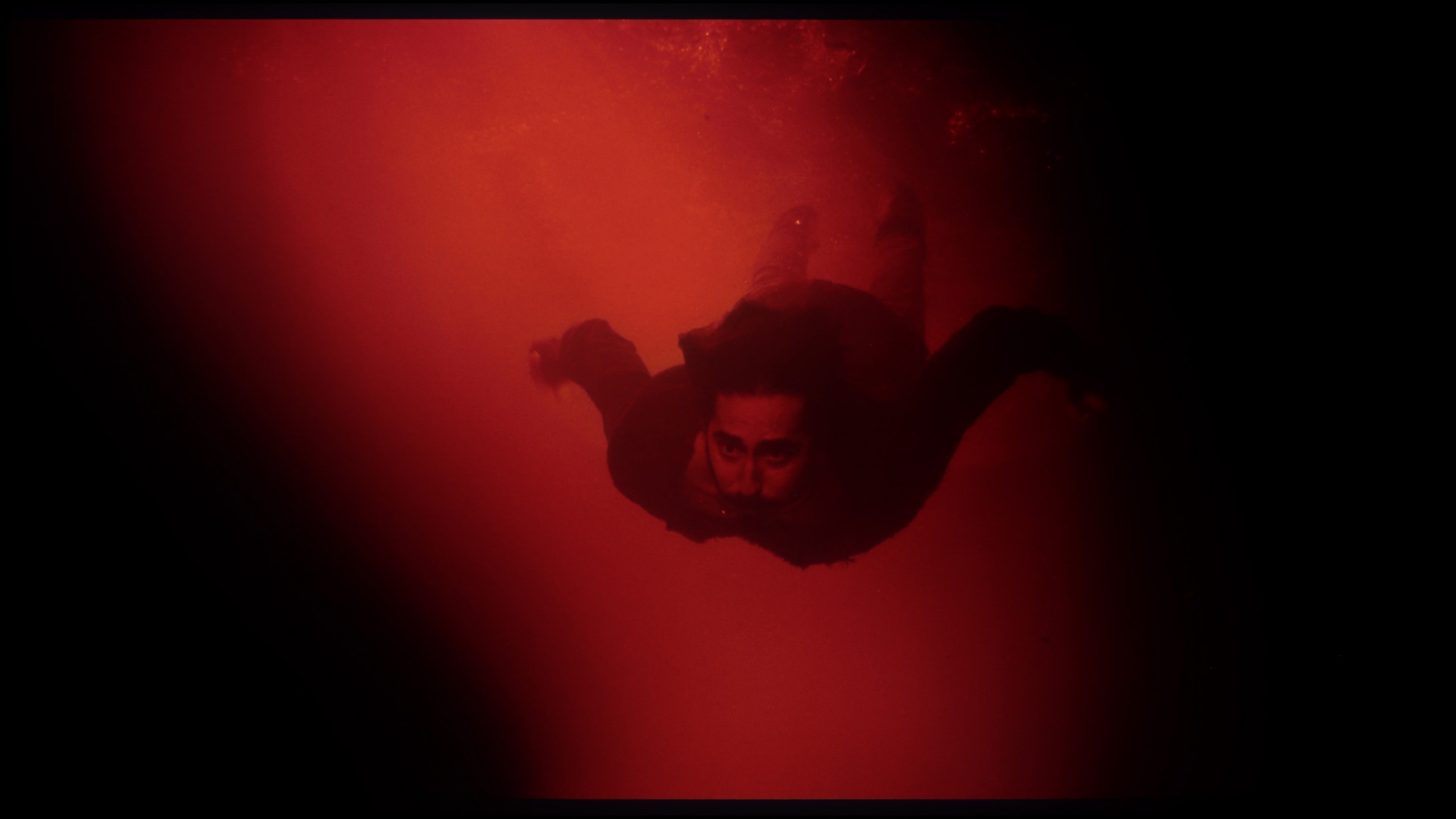




No and here we must honestly admit – the S90F has somewhat let us down. Compared to last year's S90D model with a WOLED panel (very similar to the one used this year), this year's Samsung performed worse. And this is not only against its main competitor, LG C5, but even when compared to its older brother. The biggest issues arise in dark scenes, where difficulties with smooth colour transitions are noticeable – the screen slightly steps the tonal transitions, causing some sections to lose their naturalness. We’re not sure what exactly went wrong – perhaps it's a software issue or a different processing algorithm. It's a shame, because we hoped that the level from last year would at least be maintained. Unfortunately, it's a step backwards.
When it comes to tonal transition fluidity, the Hisense U8Q left a really great impression on us. Even in the darkest scenes, where usually other TVs show ugly banding and unpleasant transitions, here the picture remains smooth and cohesive. Nothing is separating, there's no "banding" effect – everything looks just as it should. Similarly, in brighter shots – it's also very good. Sure, if we were looking through a magnifying glass, we might find some minor flaws, but in normal viewing, it's hard to pick on anything. Overall, it performs very, very well!
Image scaling and smoothness of tonal transitions
7.5/10
8/10
Smooth transition function
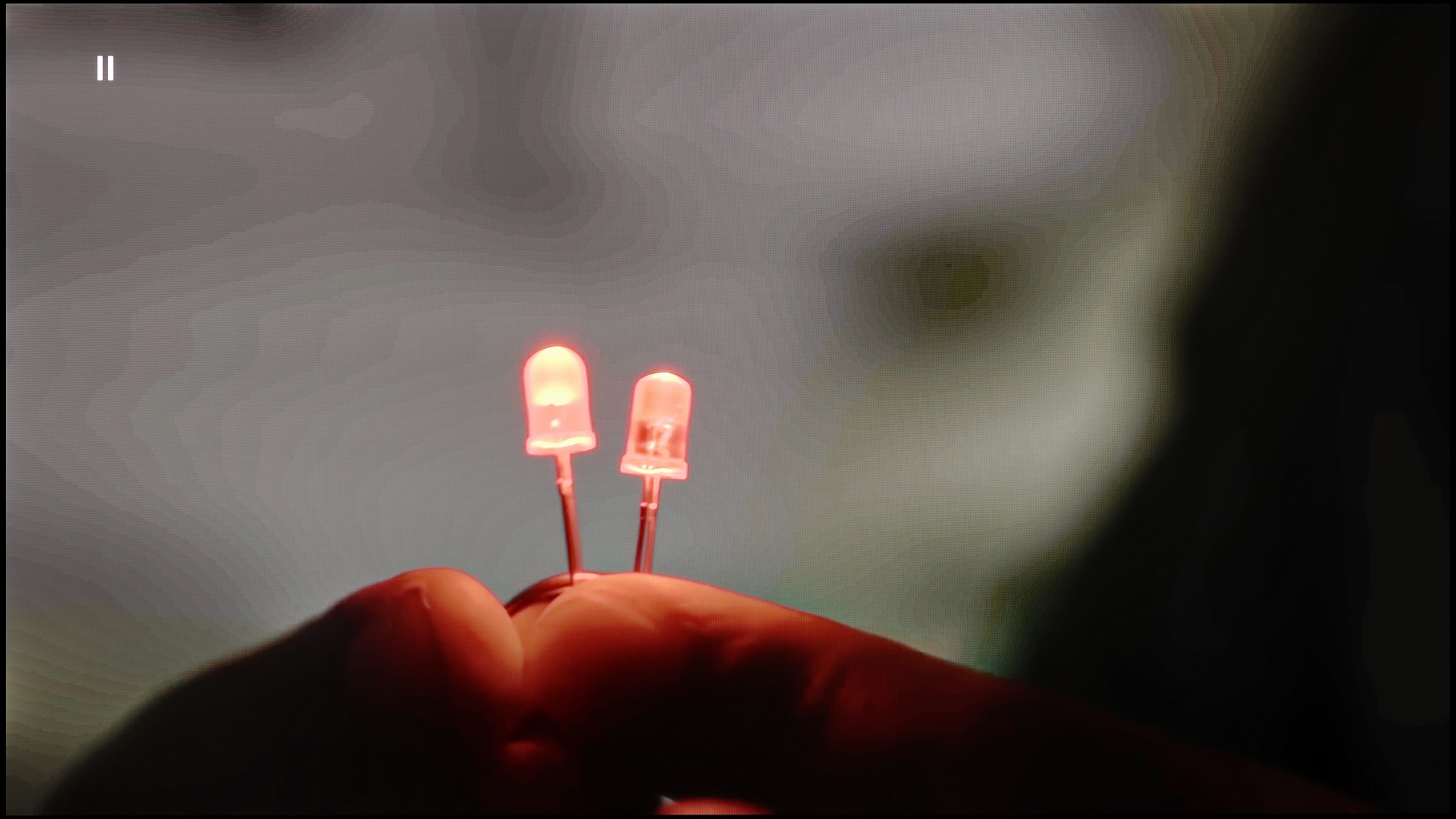
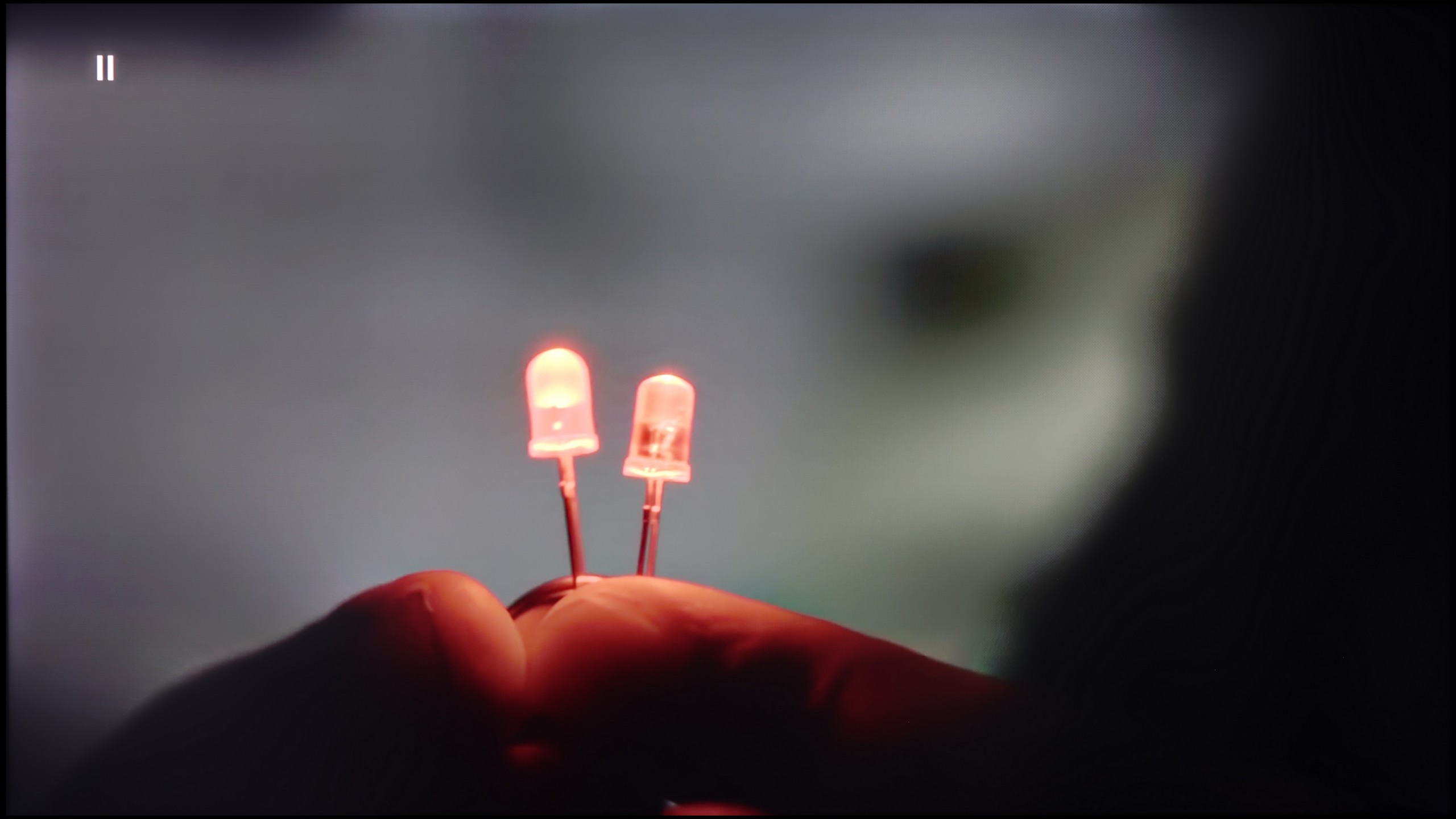
Image without overscan on the SD signal


Digital Image Processing in S90F:
Fortunately, Samsung, like in most of its models, manages to effectively tackle the unwanted posterisation effect in the S90F. The function responsible for this element is noise reduction, which does a pretty good job of smoothing tonal transitions and eliminating unnatural colour blending – of course, within its capabilities. Unfortunately, it works quite aggressively, so using it comes with trade-offs. In addition to improving gradation, it can also remove film grain or slightly soften facial features. In this case, the choice is yours – do you prefer a more "clean" image, or do you care about preserving the original texture of the material.
Image Scaling in S90F:
In this year's model, Samsung has implemented its proprietary AI processor – NQ4 Gen3, which really handles upscaling quite well. In our test scenes, the TV effectively "pulled up" lower quality towards artificial 4K – the image was more enjoyable to view, and the differences in sharpness between native and scaled content were minimal. Unfortunately, behind all this AI marketing façade lies a certain shortcoming. The S90F struggles with overscan. If you reach for truly archival material – e.g. a VHS tape of your parents' wedding – you have to reckon with the fact that the lower part of the image may get cut off. The function to adapt the image to resolution simply does not work as it should here.
Hisense U8Q handles lower quality materials quite well. The television can smooth tonal transitions thanks to the “Smooth and Gradient Picture” feature – it works best on the Medium setting. It nicely dims unwanted bands and irregularities in the image, but importantly, it doesn't remove the film grain or fine details.
The upscaling itself is also at a good level. Image from lower resolutions appears smooth and soft, sometimes a bit too much – we get a plastic effect that may not appeal to everyone. Fortunately, this can be easily corrected with the sharpness slider, allowing you to adjust the image to your personal preferences.
Blur and motion smoothness
8.5/10
7.8/10
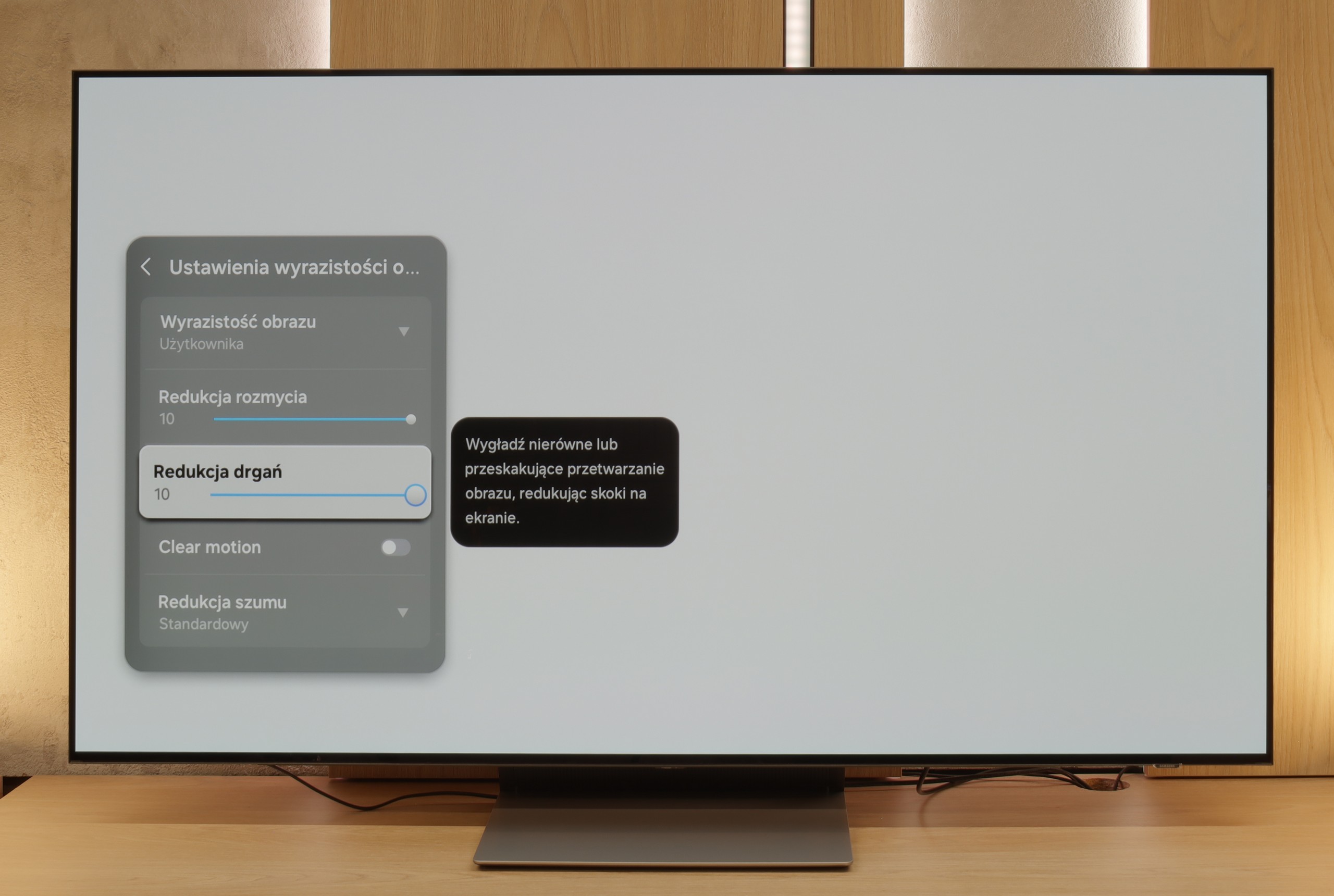
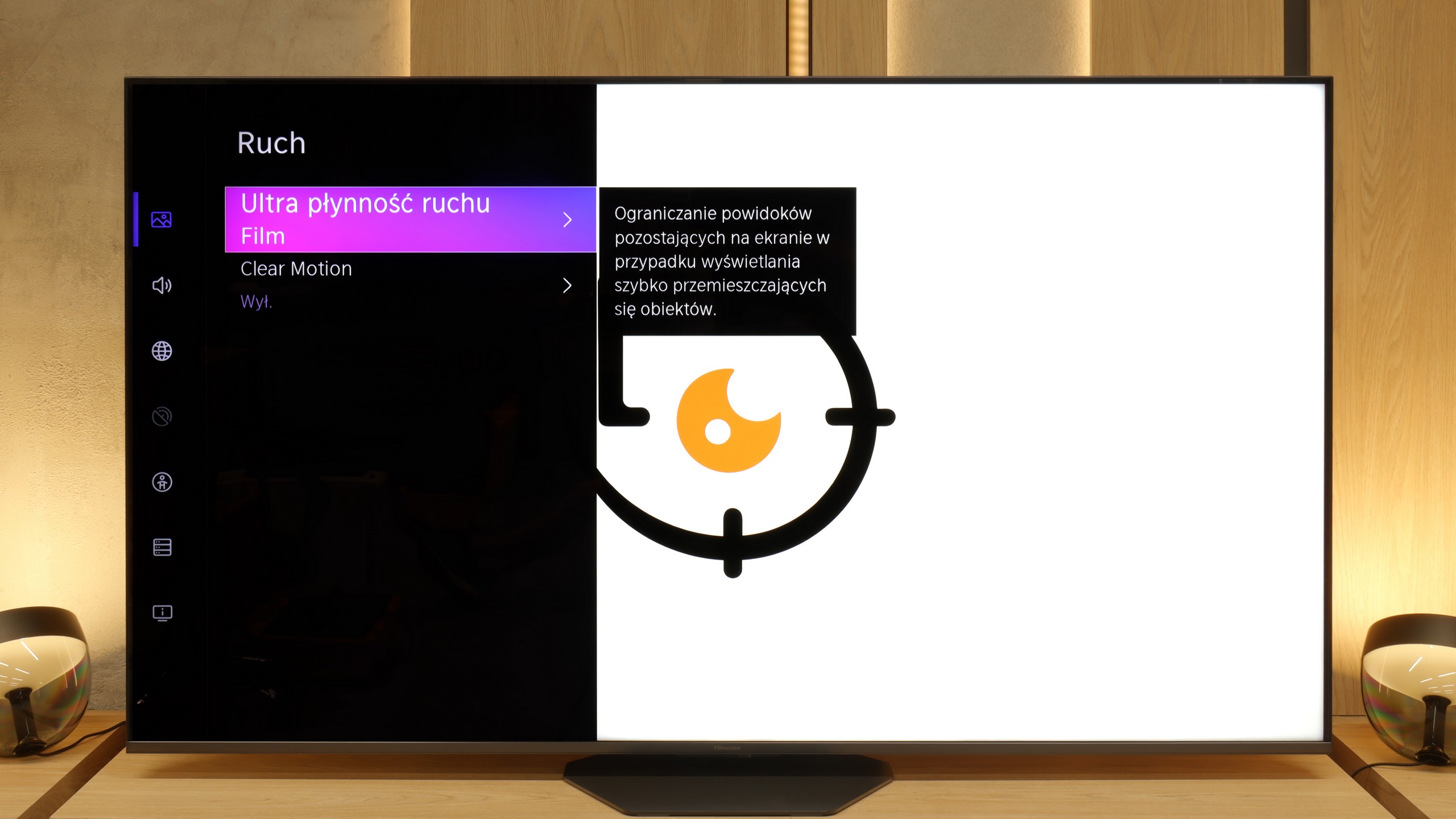
Blur (native resolution, maximum refresh rate):
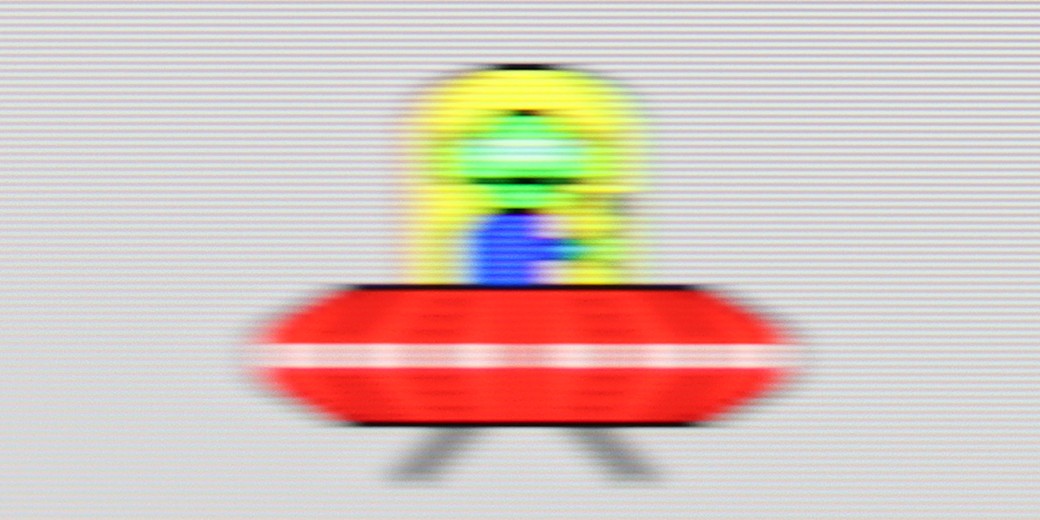



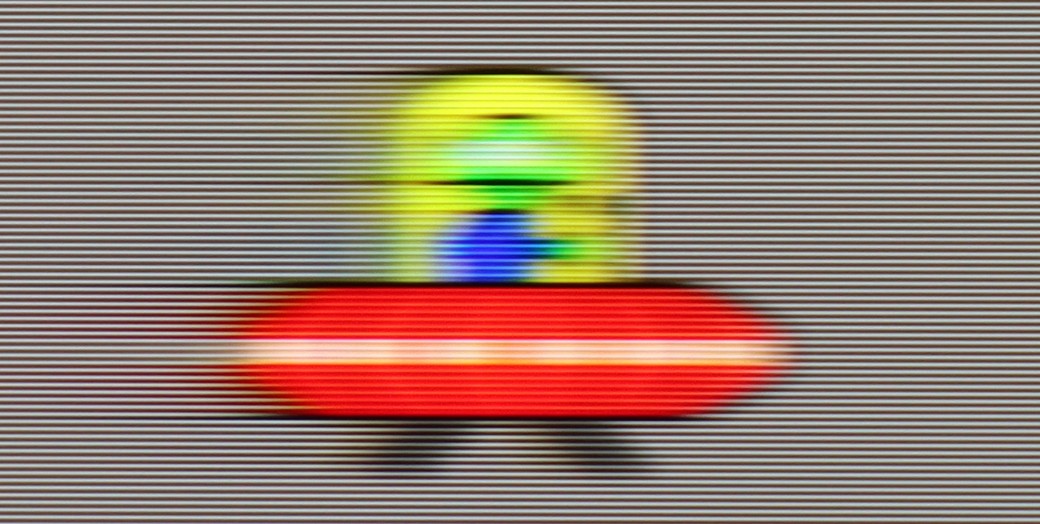

Blur (BFI function enabled):
Image flickers in this mode



Smużenie ():
Smużenie (1080p@288Hz):

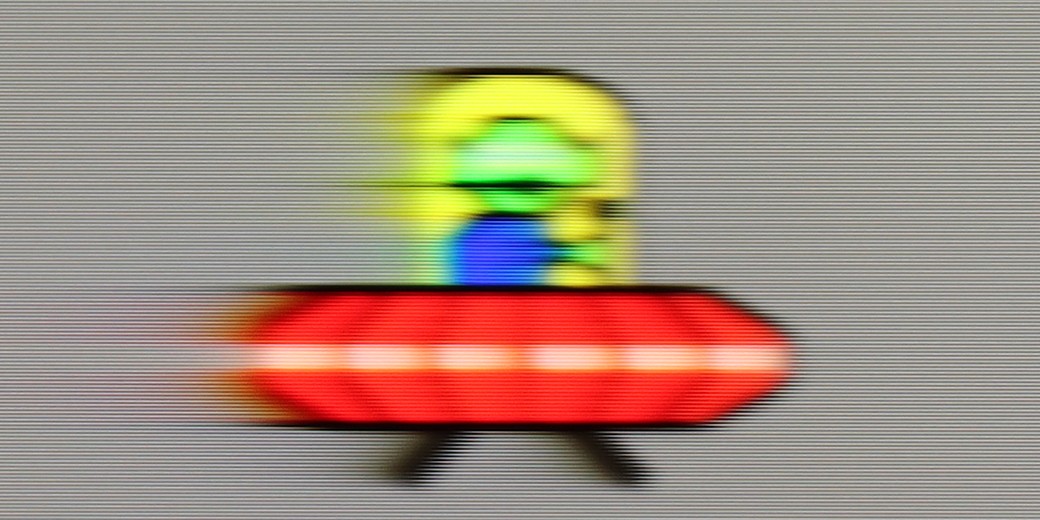

S90F really handles motion excellently – after all, it’s an OLED with a 144 Hz panel, so sports and games look absolutely stunning on it. The image is smooth, clear, and there’s no room for ghosting or blurring, which can sometimes plague cheaper LCDs.
The TV also comes equipped with motion smoothness settings that allow you to customise everything to your liking. We have motion blur reduction and judder reduction – you can set it so that the image is super smooth (even to the point of looking a bit soap opera-like), or more cinematic, with the classic “jumpiness” of 24 frames. The choice is yours, Samsung imposes nothing.
Hisense U8Q has a panel that can refresh the image up to 165 Hz in 4K resolution. In practice, this will mainly benefit PC gamers, but as they say – better to have it than not 😊. For movies and series, we have a built-in smoother called Ultra Motion Smoothing. In the settings, it can be easily adjusted to your own preferences – whether you want a more ‘cinematic’ frame rate or a smooth, theatrical spectacle.
Console compatibility and gaming features
9.5/10
8.5/10
- ALLM
- VRR
- VRR range48 - 144Hz48 - 288Hz
- Dolby Vision Game Mode
- Correct implementation of HGIG
- 1080p@120Hz
- 1440p@120Hz
- 4K@120Hz
- Game bar
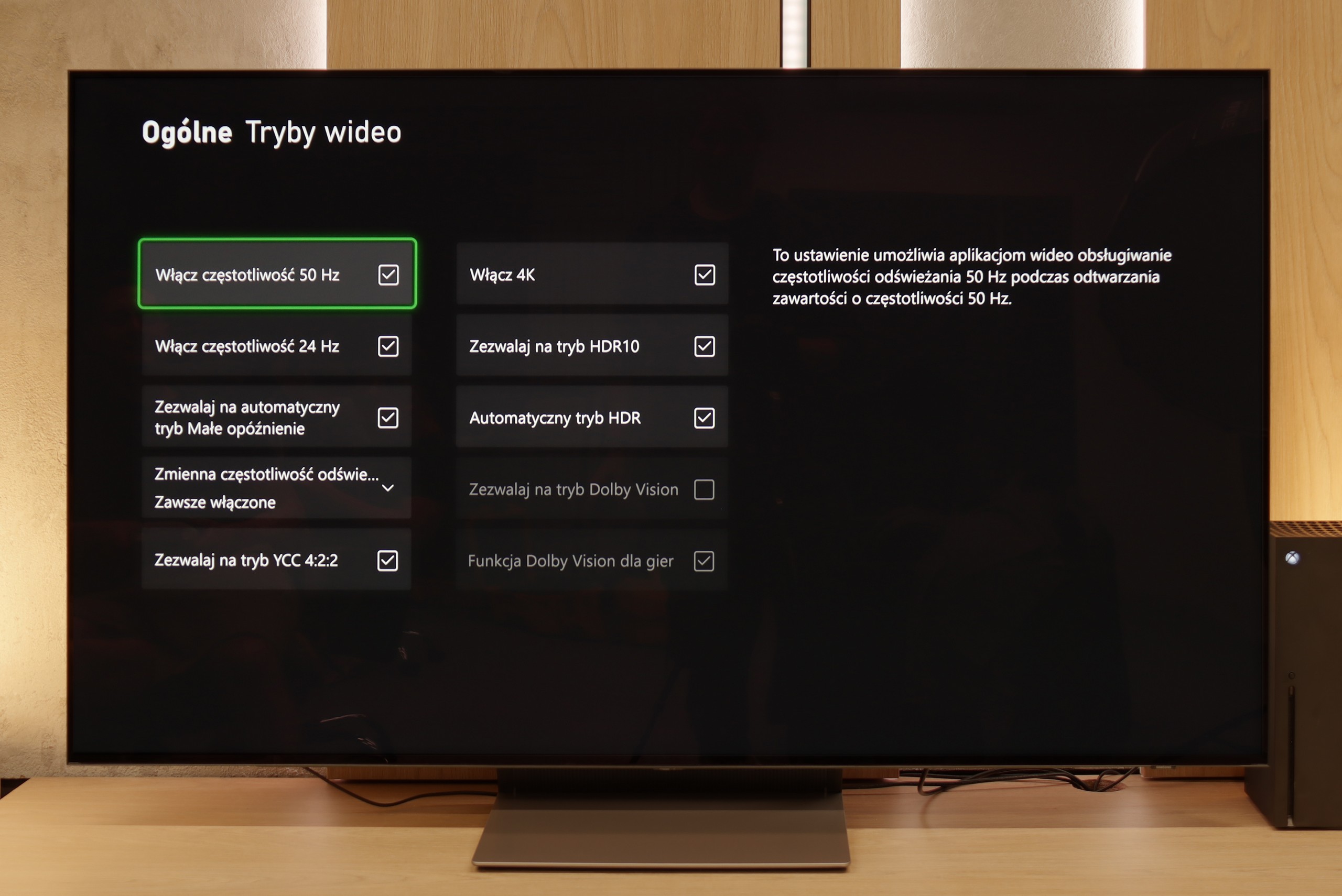
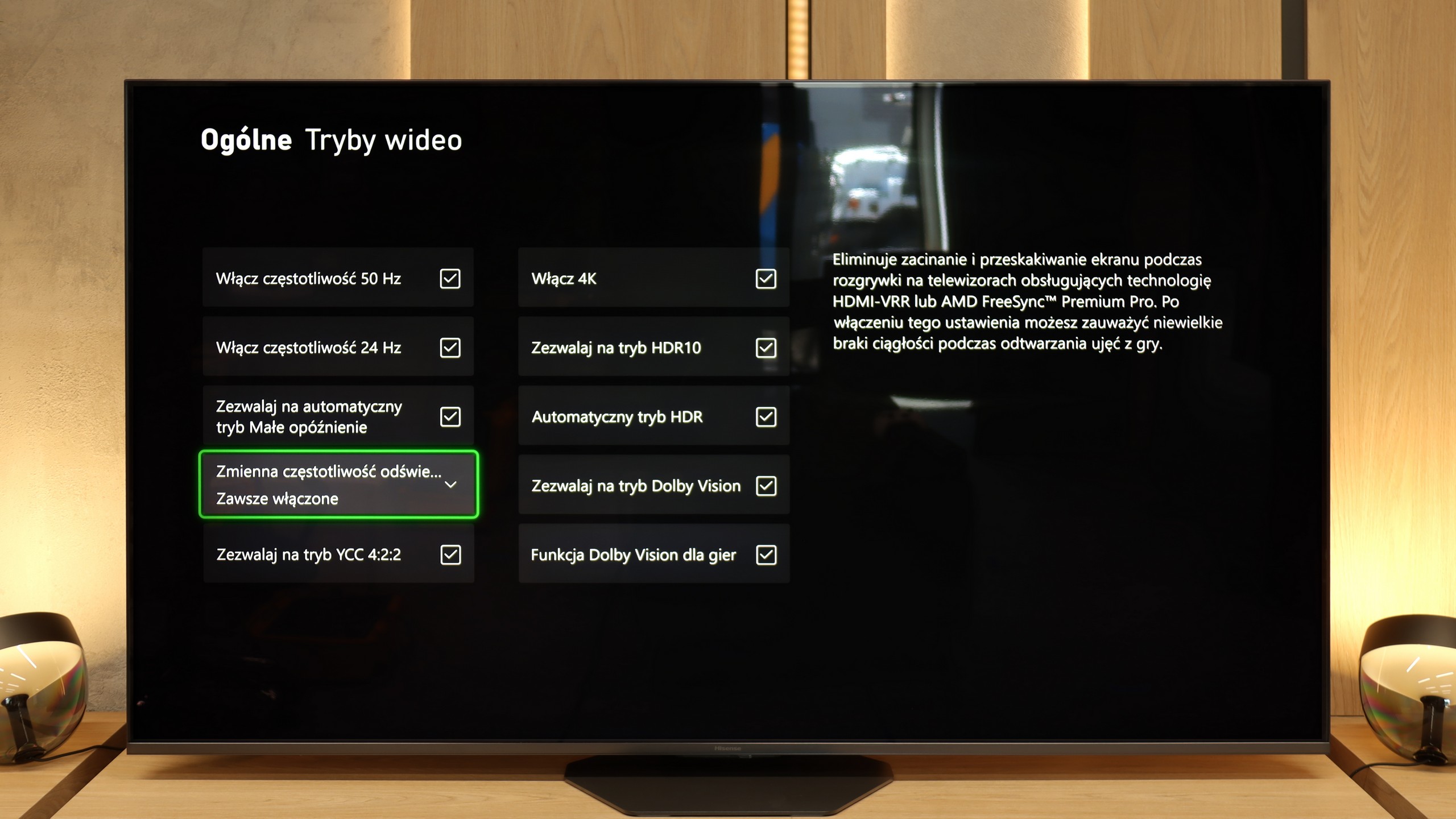
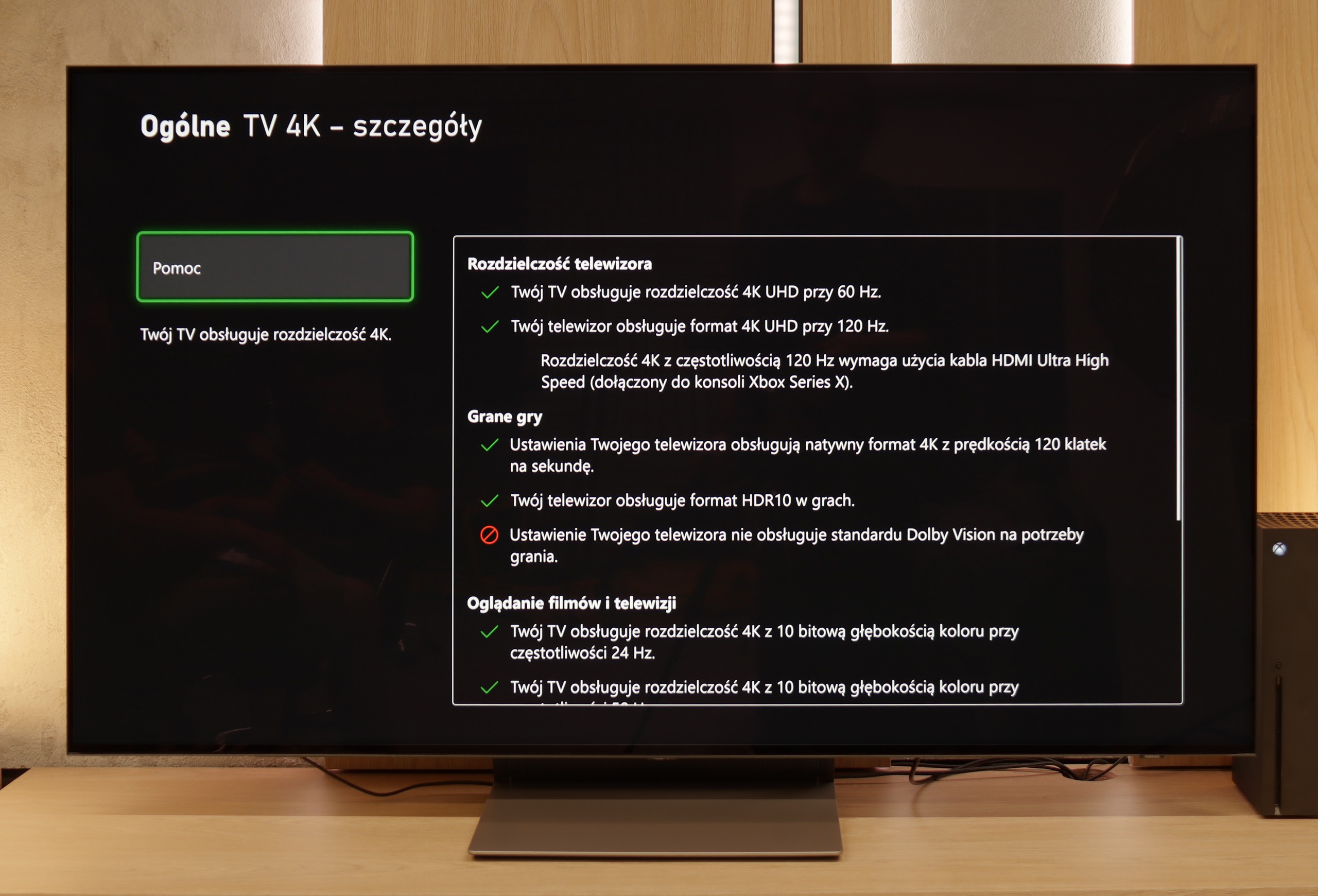
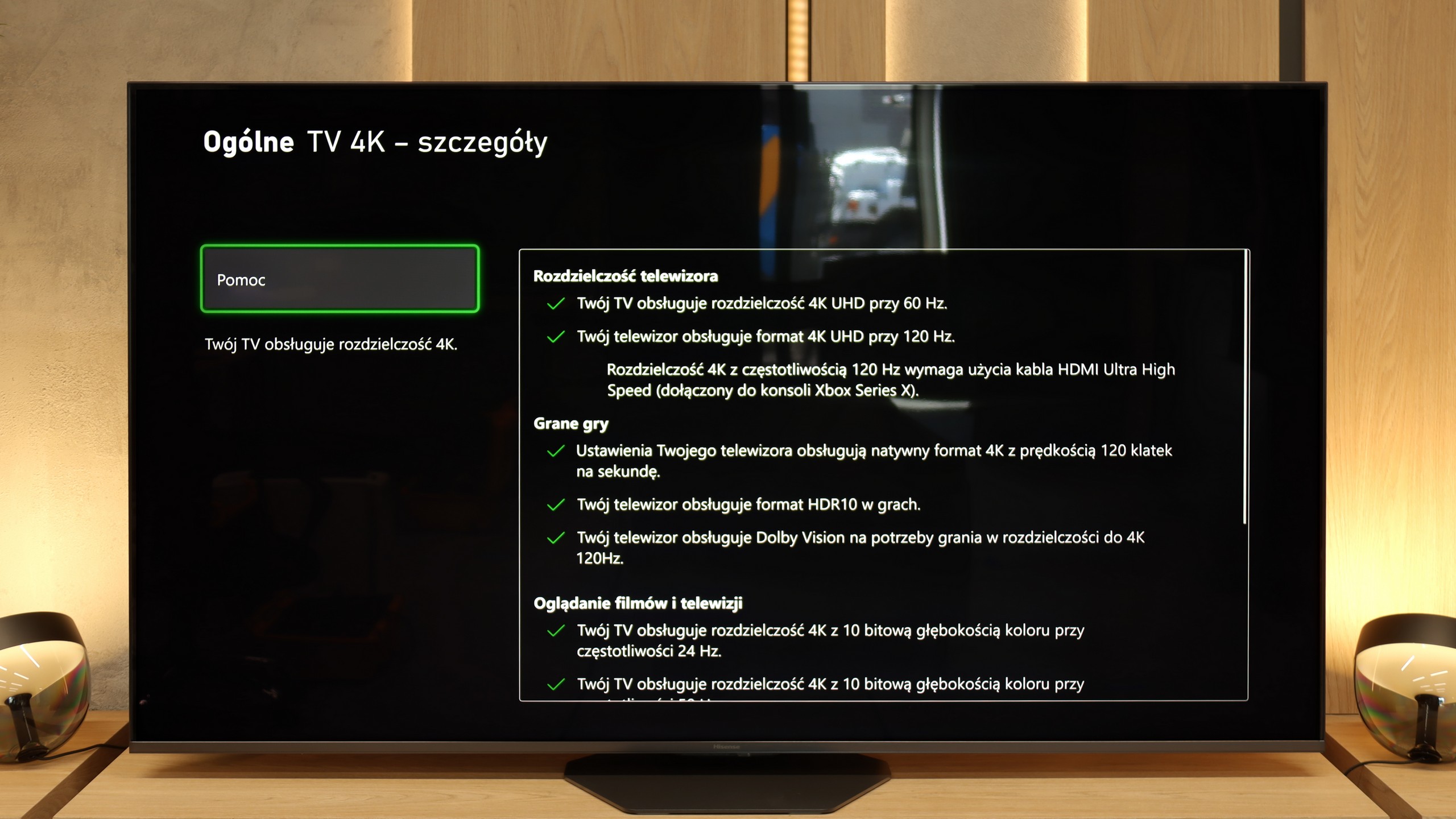
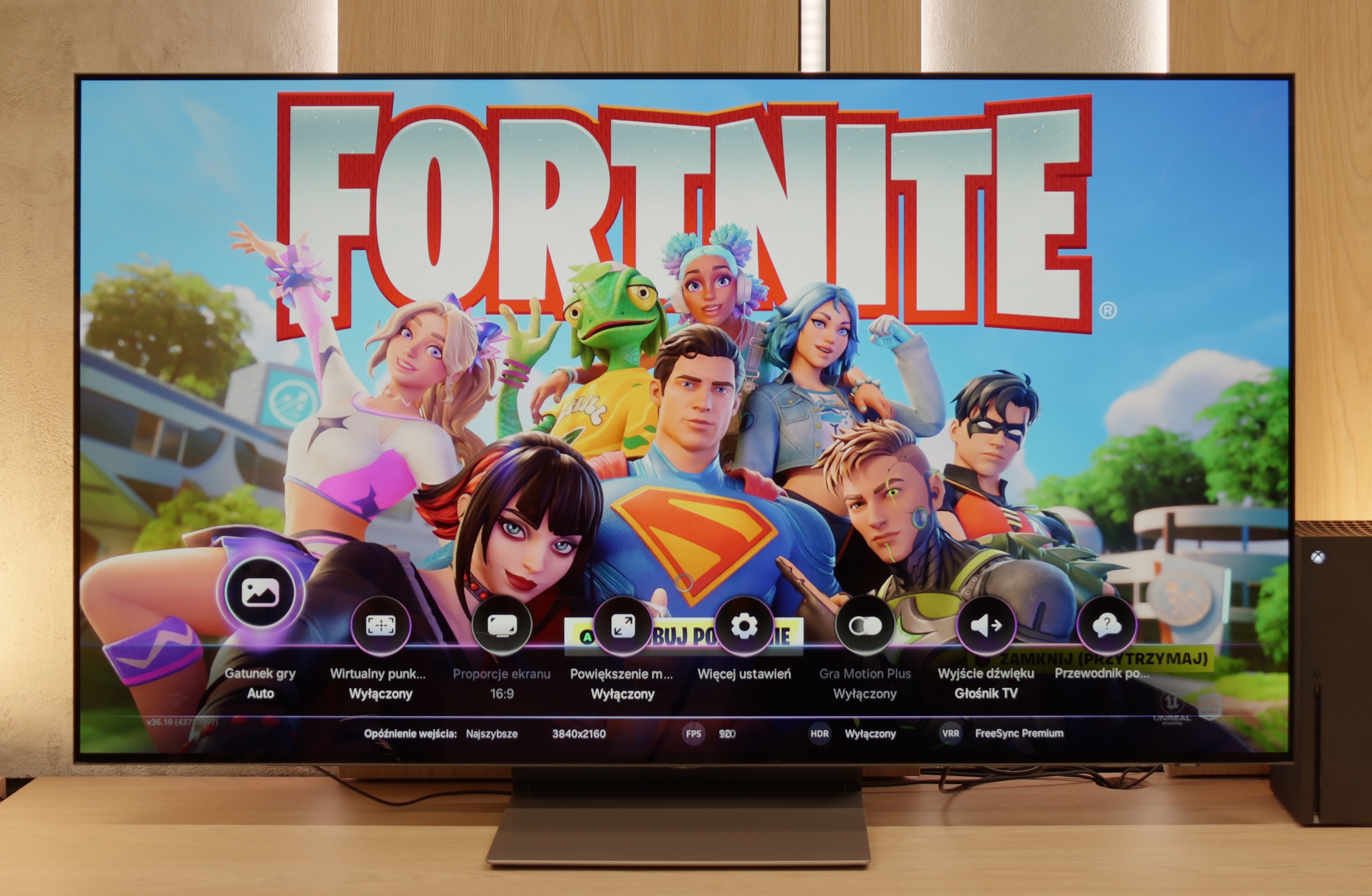
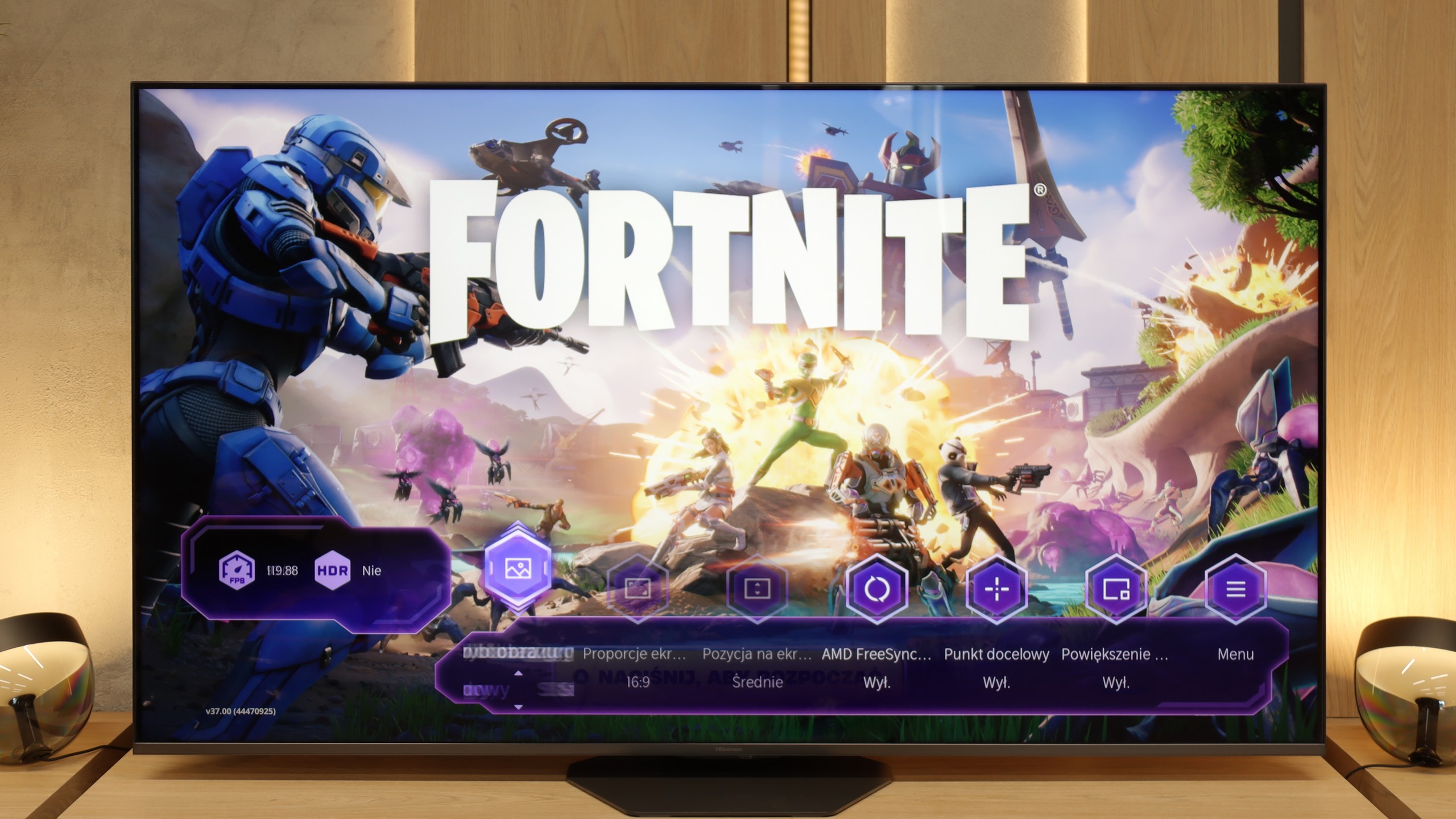

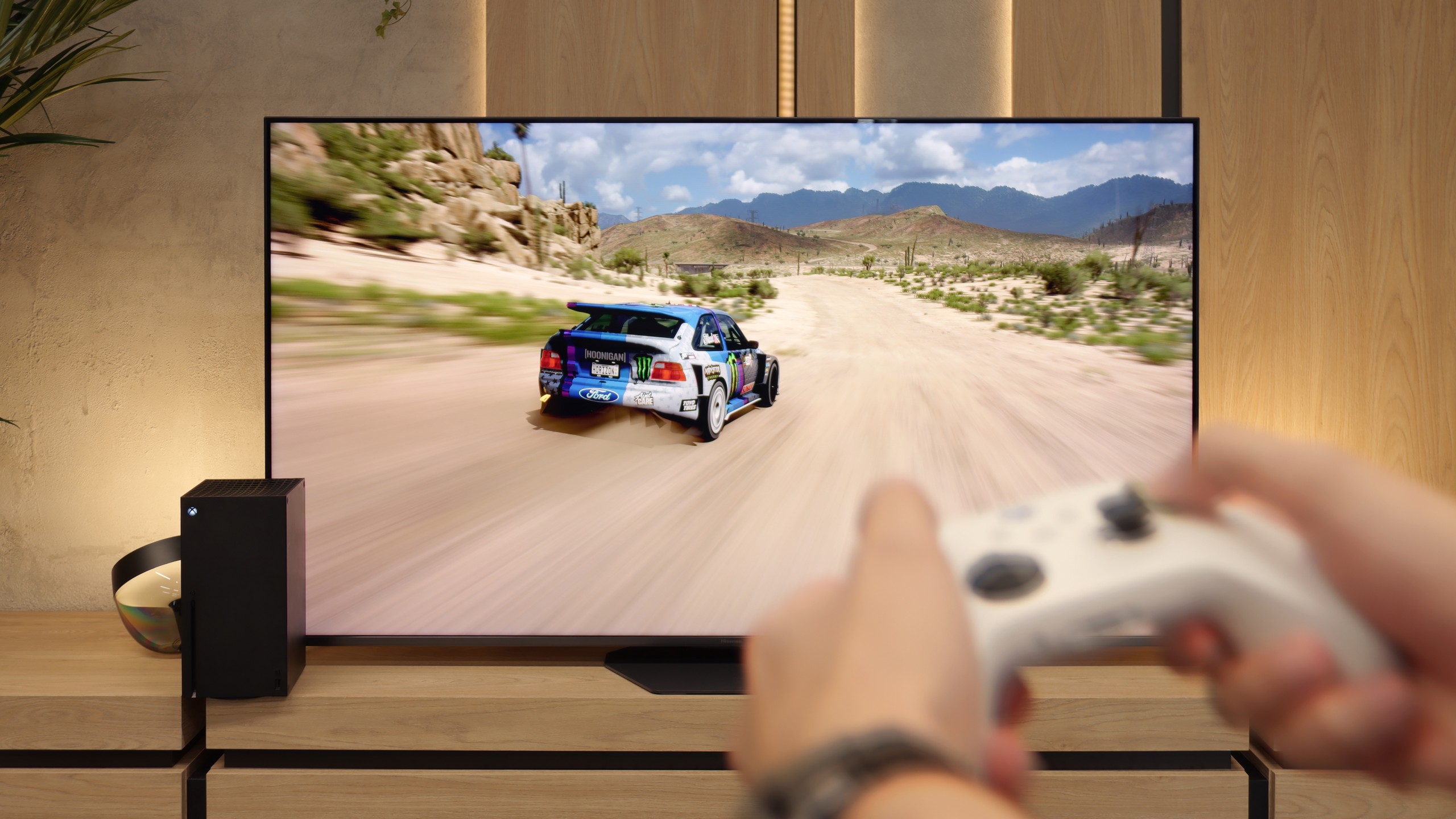
When it comes to gaming features – the S90F has absolutely nothing to complain about. Aside from the lack of Dolby Vision, which is already the norm for Samsung. The television operates at 144 Hz, has four HDMI 2.1 ports, so you can easily connect more than one console or PC. Onboard, we also find Game Bar – a practical tool that allows you to quickly preview picture settings, VRR status, ALLM mode, and other useful options. Game Motion Plus deserves special mention – Samsung's proprietary motion smoother that actually works sensibly in games. The image appears smoother, but without any artificial effects or slowdowns.
It's also worth mentioning the HGiG feature, which – and this may be a slight surprise – works correctly. We bring this up because Samsung clearly messed something up in one of the recent updates, and in some models, the option responsible for HGiG simply... disappears from the menu. Setting it up becomes almost impossible. Fortunately, our S90F unit did not have this issue, but the situation is dynamic, so it's worth keeping this in mind and regularly checking for new software versions and information from the manufacturer.
In terms of features, the Hisense U8Q has practically everything one would expect from a modern gaming television. Thanks to the new processor, the manufacturer has managed to implement three HDMI 2.1 ports, so there’s no trouble connecting multiple consoles or a computer. On top of that, it includes all the key technologies – Game Bar with parameter previews, variable refresh rate (VRR), automatic game mode (ALLM)… in a word, a complete set.
But as often happens with Hisense, it’s missing just a bit from perfection. The biggest drawback remains the lack of support for the HGiG format, which allows the TV's brightness to be adjusted to the console and gets the most out of HDR in games. It’s a shame because if this feature were included, we’d have a device practically made for gamers. As it stands, the U8Q remains “only” a very good choice 😉
Input lag
10/10
9.8/10
SDR
HDR
Dolby Vision
Input lag in the S90F is at a level that's practically monitor-like. Under the best conditions, it achieved a score of 5 ms, which is an absolutely stunning result – even a benchmark for the most demanding gamers. Whether you're playing fast-paced shooters, fighting games, or simply need instant response – the S90F does not disappoint in this regard at all.
The Hisense U8Q really performs well in terms of signal delay. In 120 Hz mode, the input lag is around 10 ms, and with 60 Hz content, it hovers around 18 ms. These are values that place it among the fast televisions, and in practice, it's hard to have any significant reservations about them. The reaction is instant, controlling a character or a car on screen occurs without noticeable delays. Regardless of whether someone is playing dynamic shooters or calmer narrative titles, the U8Q will perform excellently.
Compatibility with PC
8.6/10
8.4/10
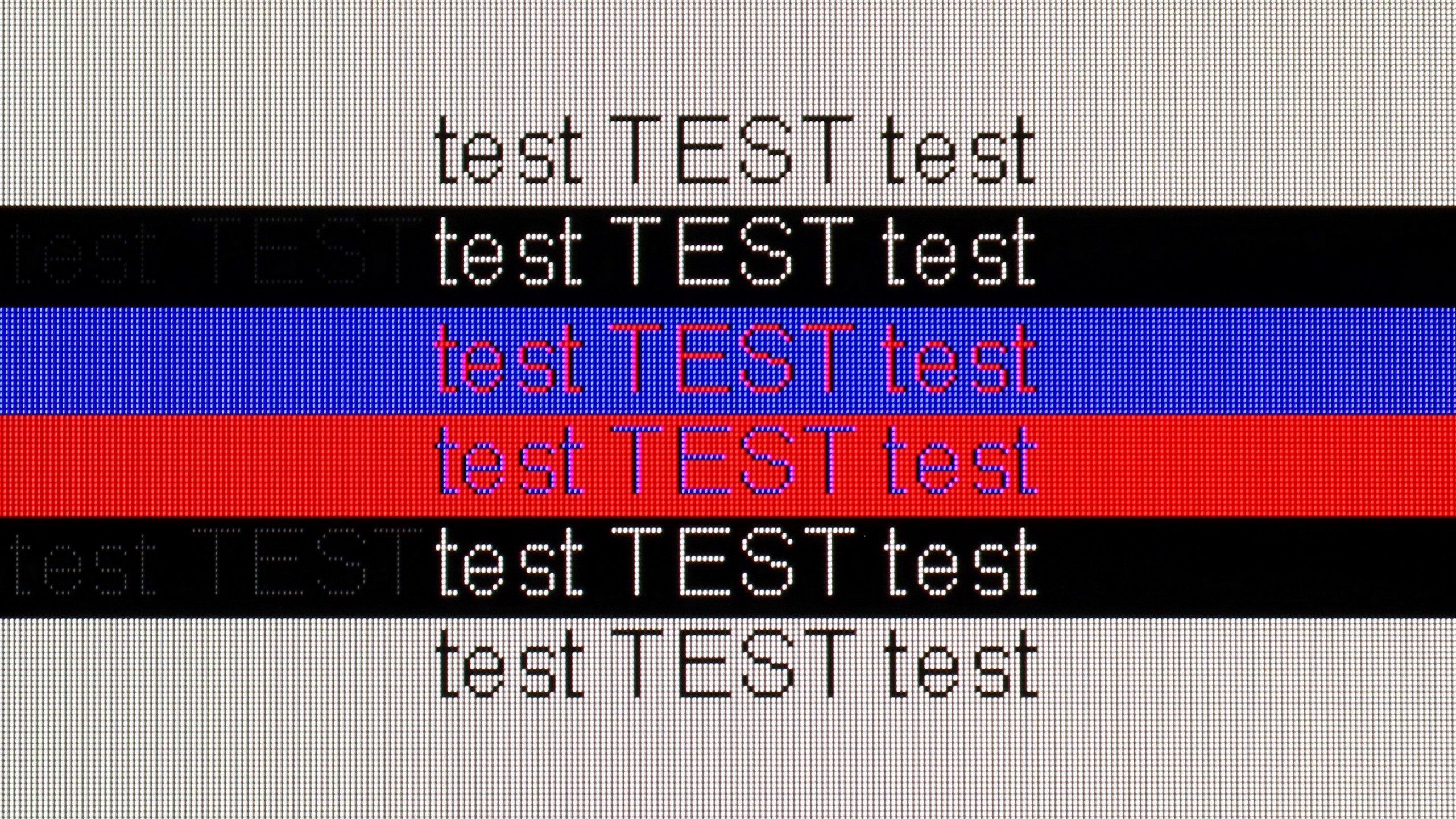
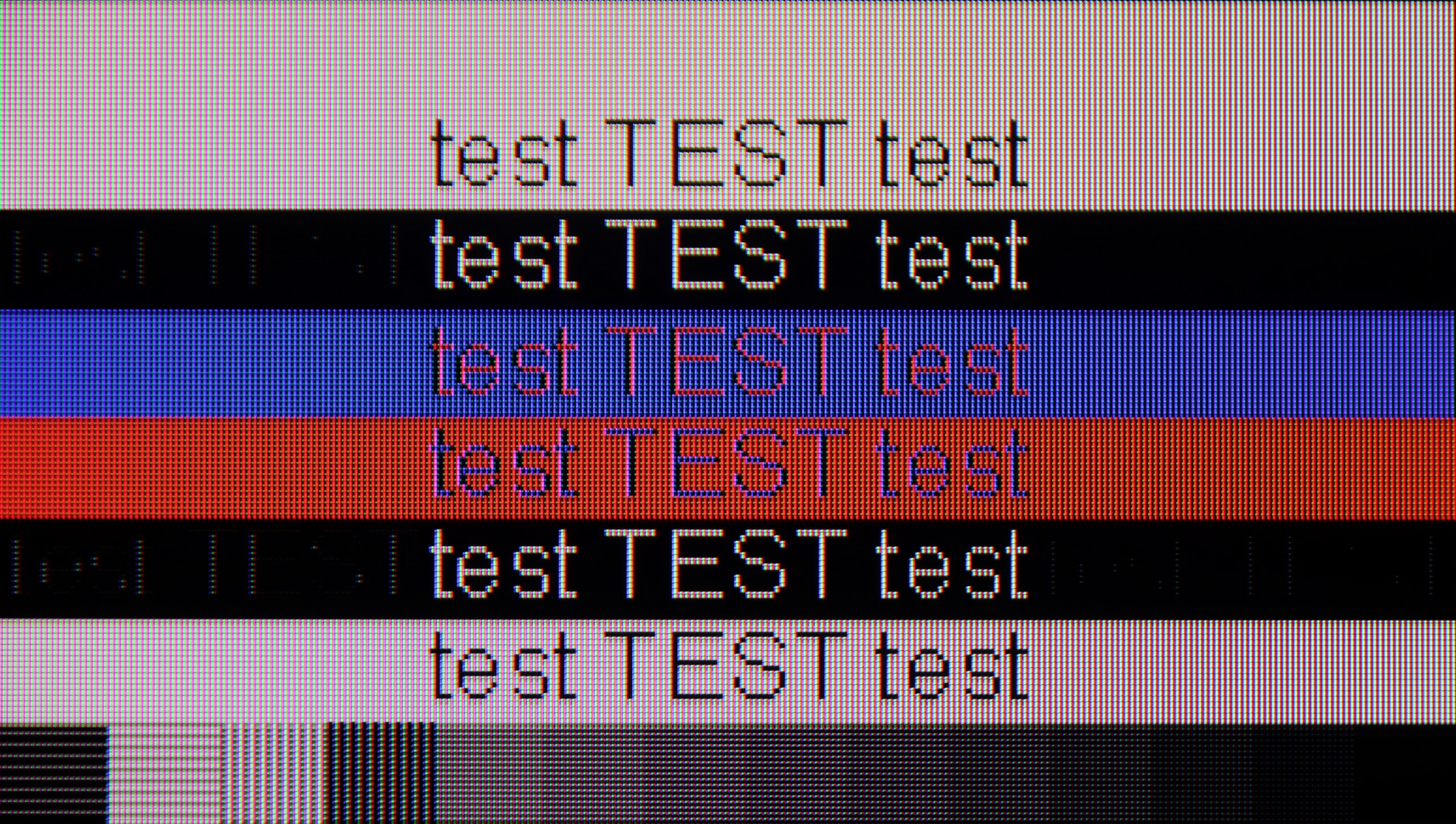
S90F is a great tool for both gaming on PC and daily work. Gamers can rest easy – the TV effortlessly supports image synchronisation with NVIDIA graphics cards thanks to G-Sync, and the 144 Hz refresh rate combined with very low input lag only confirms this. S90F also excels as a monitor for working with text. Of course, the readability of fonts may be slightly compromised by the characteristic pixel structure in the RWGB arrangement, but this is a topic well known primarily to those who work with a lot of text, code, or Excel spreadsheets. For most users, this will be perfectly acceptable.
As we mentioned regarding the features for gamers – the Hisense U8Q also communicates well with computers. The 4K display with a refresh rate of 165 Hz is impressive on its own, and at Full HD resolution, it can even "overclock" to 288 Hz. This is great news for e-sports fans, where speed of reaction counts more than the highest quality of image. Additionally, it supports G-Sync and FreeSync, making gameplay smooth, without stutters or annoying frame tearing.
A pleasant surprise is the presence of a USB-C port with DisplayPort functionality for laptops or even phones. This is a true novelty in televisions, and it’s quite possible that Hisense will be a pioneer here, setting the direction for the competition.
However, when it comes to working with text, we must mention one minor inconvenience. Although the U8Q correctly handles chroma 4:4:4, it has difficulty displaying very thin, horizontal fonts. This means that some subtitles or interface elements may be hard to read. Most people aren’t buying this model with the intention of office work, but if someone had such a plan – it’s worth keeping this in mind.
Viewing angles
7.4/10
3.2/10
The viewing angles on the S90F are very good, although it must be honestly admitted that they are slightly inferior to the 65" version with the QD-OLED panel. Nevertheless, the picture quality at wide angles performs very well – colours remain vivid, and brightness doesn’t drop dramatically when viewed from the side. There's no need to move the TV closer to see a clear image. For most users, this level is more than sufficient.
In terms of viewing angles, the Hisense U8Q performs averagely – typical for VA panels. It's a classic compromise: in exchange for much better blacks and contrast than with IPS panels, we have to accept that viewing from a wider angle doesn’t look as good. Colours start to lose their intensity, and the image lightens a bit. For someone sitting directly in front of the TV – it's fantastic. For someone who sits a bit off to the side – not so much.
TV efficiency during daytime
6.1/10
8.2/10
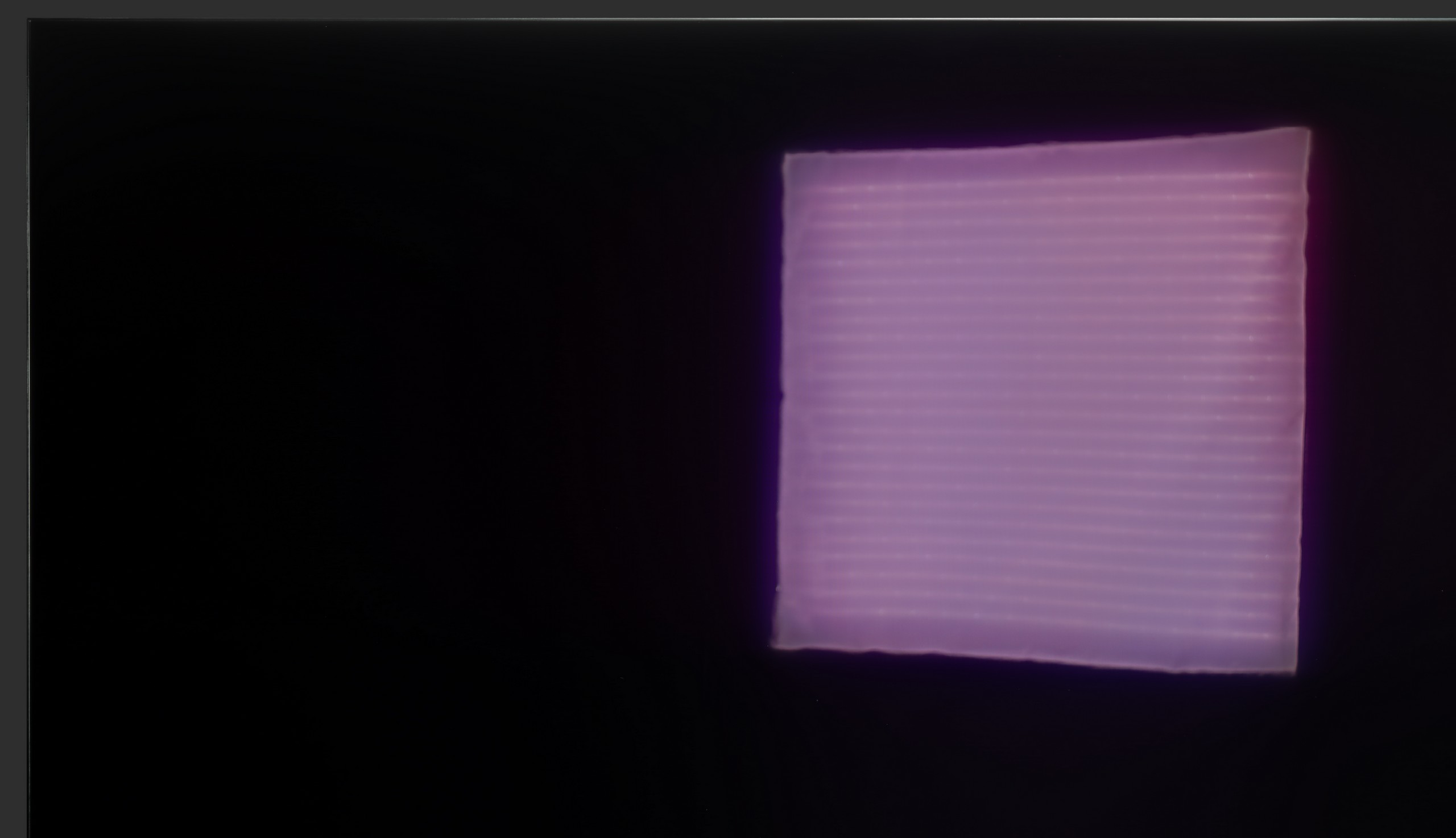
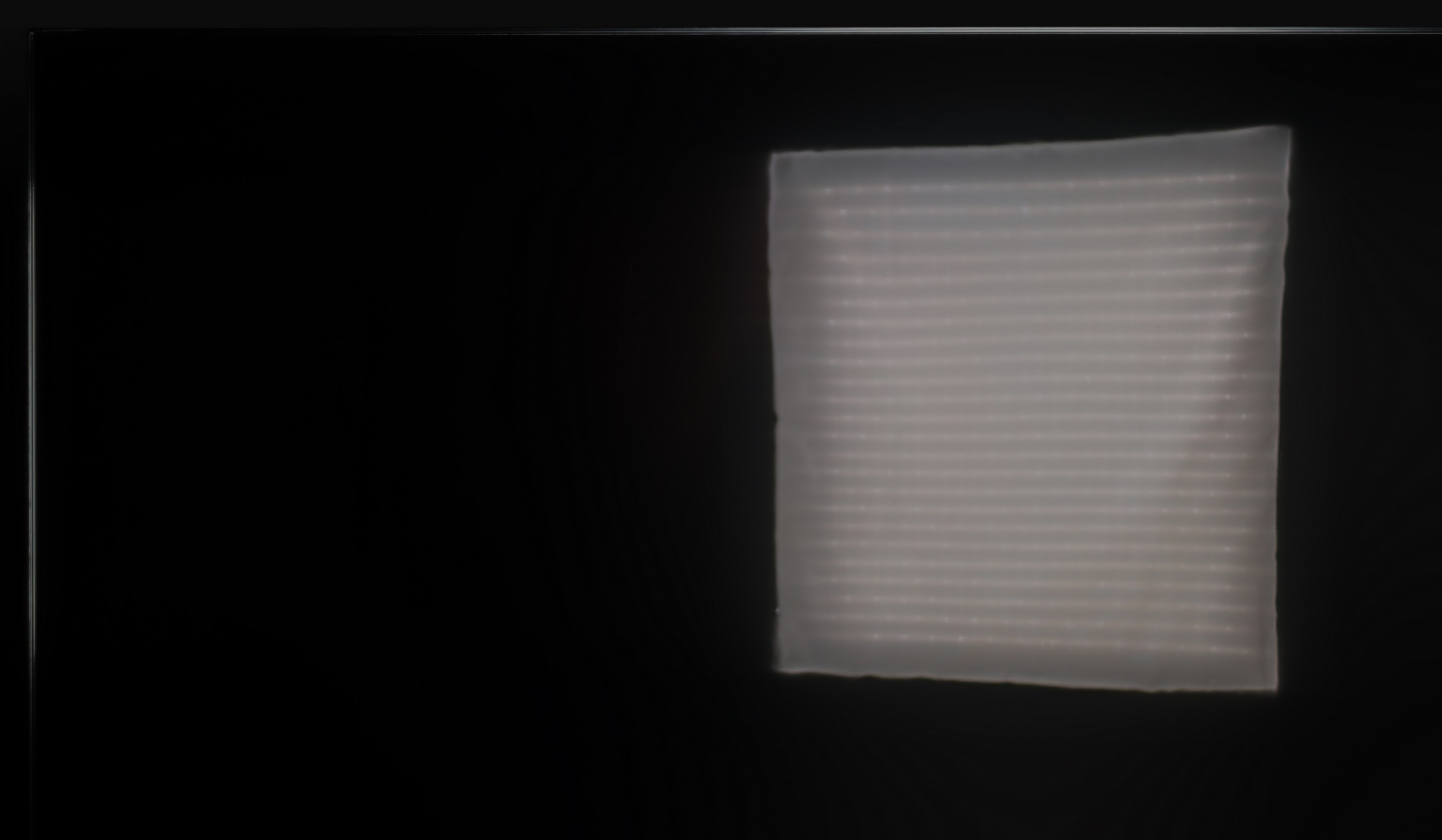
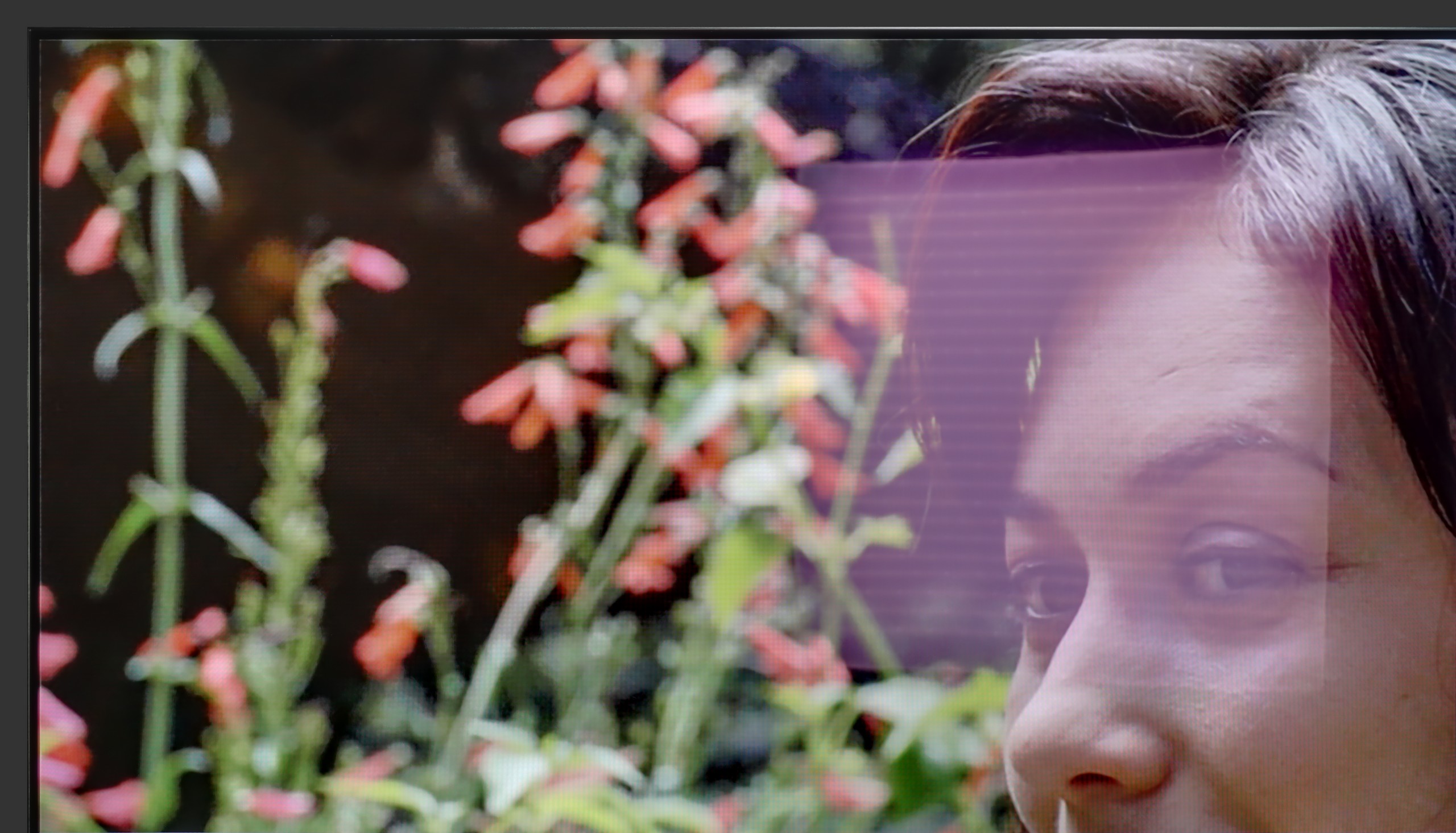

Matrix brightness
Average luminance SDR
Hisense U8Q: 914 cd/m2
SAMSUNG S90F (WOLED): 405 cd/m2
S90F is really bright for an OLED TV. Of course, it shouldn’t be compared to Mini-LED TVs or the brightest high-end OLEDs, but under normal lighting conditions, it’s easy to watch something during the day. The brightness is high enough that there’s no need to close the curtains every time a movie or series is turned on. However, it’s important to remember that the anti-reflective coating on WOLED panels is not the best. Reflections can be noticeable, especially with bright light coming in from the window. In such cases, it’s best to reach for curtains.
Hisense has introduced a new anti-reflective coating called Anti-Reflection PRO. It aims to improve viewing comfort in difficult lighting conditions – and it really does the job. Reflections don't disappear entirely, but they are well controlled and do not interfere with everyday viewing. However, the highlight is the brightness in SDR – around 1000 nits! That's a result that would make top super premium models proud. As a result, the U8Q performs excellently in sunny rooms and can definitely be considered one of the best televisions for daytime viewing.
Details about the matrix
Subpixel Structure:
Panel uniformity:
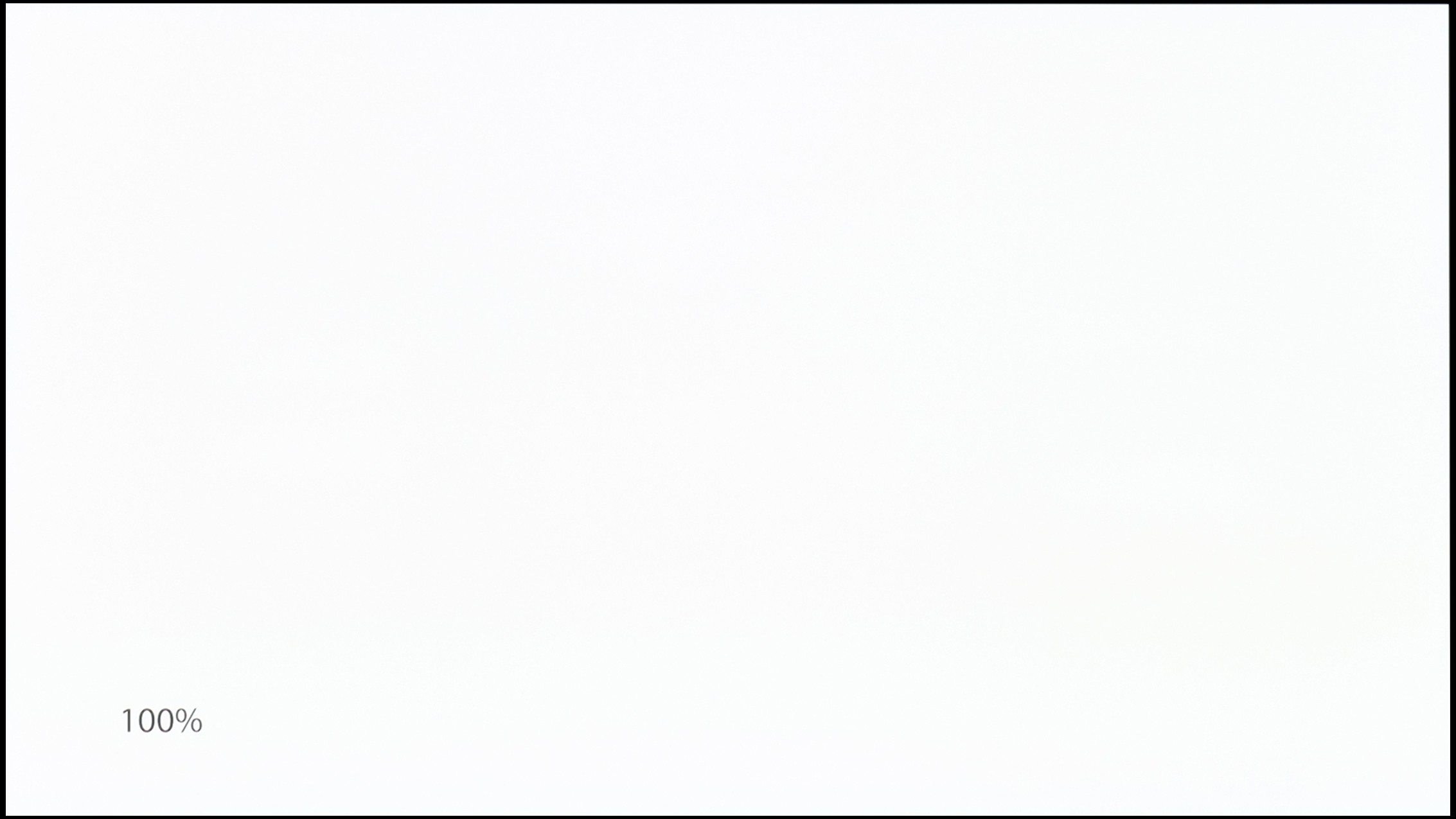
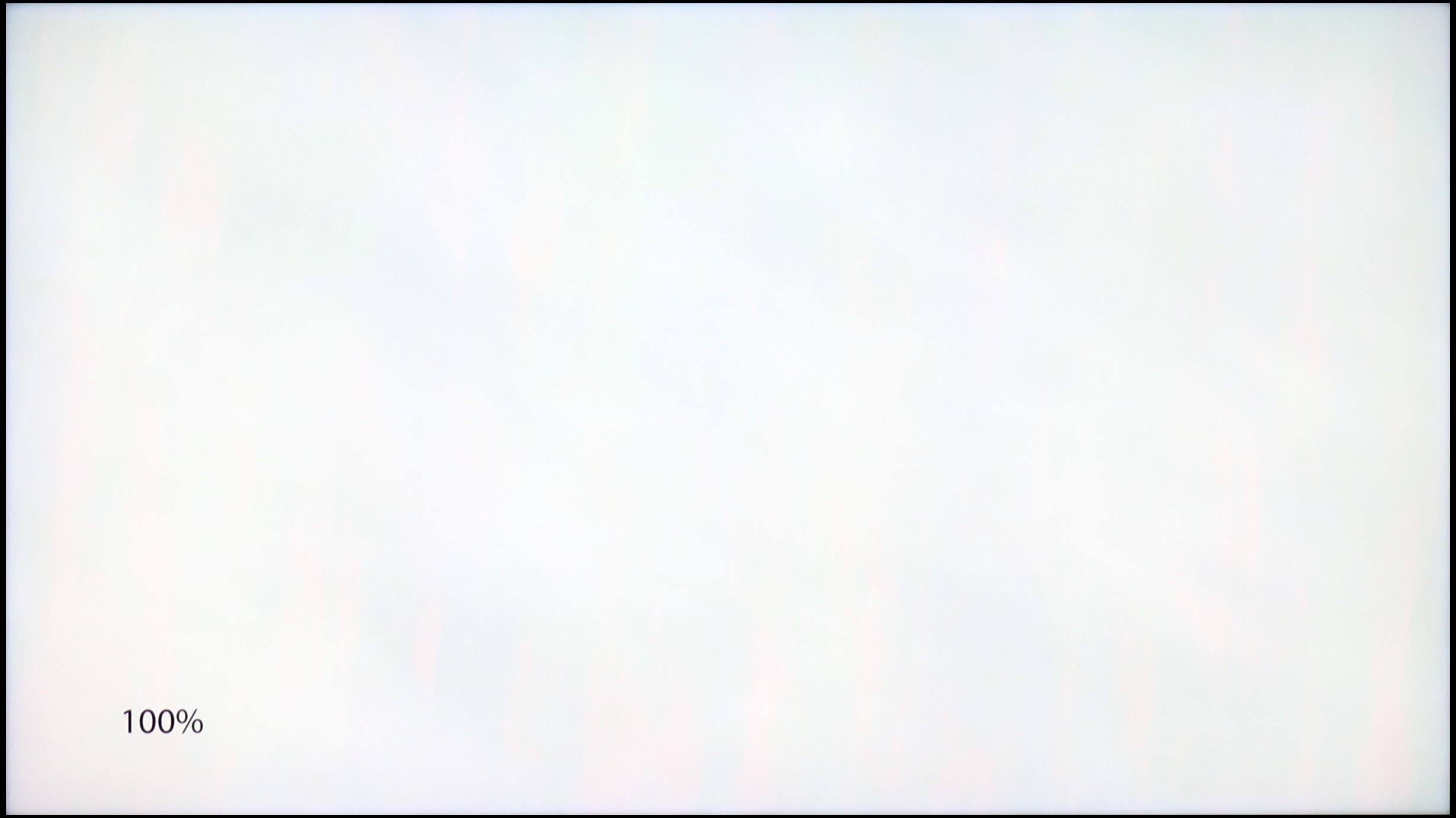
TV features
7.2/10
9.4/10
- HDMI inputs0 x HDMI 2.0, 4 x HDMI 2.1 48Gbps0 x HDMI 2.0, 3 x HDMI 2.1 48Gbps
- Other inputsToslink (Optical audio), IR (remote)Toslink (Optical audio), RCA (Chinch)
- OutputsToslink (Optical audio), eARC (HDMI), ARC (HDMI)eARC (HDMI), ARC (HDMI), Mini-Jack (Headphones)
- Network InterfacesWi-Fi 2.4GHz, Wi-Fi 5GHz, Ethernet (LAN) 100MbpsWi-Fi 2.4GHz, Wi-Fi 5GHz, Ethernet (LAN) 100Mbps
- TV receptionDVB-T, DVB-T2, DVB-S, DVB-S2, DVB-CDVB-T, DVB-T2, DVB-S, DVB-S2, DVB-C
Classic features:
- Recording to USB (terrestrial TV)
- Recording programming
- Picture in Picture (PiP)
- RF remote control (no need to aim at the screen)
- Backlit remote control
- Teletext
- Audio only mode
- Possibility to connect Bluetooth headphones to the TV
- Possibility to simultaneously use Bluetooth headphones and the TV speaker
Smart features:
- AirPlay
- Screen mirroring (Windows Miracast)
- Wyszukiwanie głosowe
- Voice search in native language
- Ability to connect a keyboard and mouse


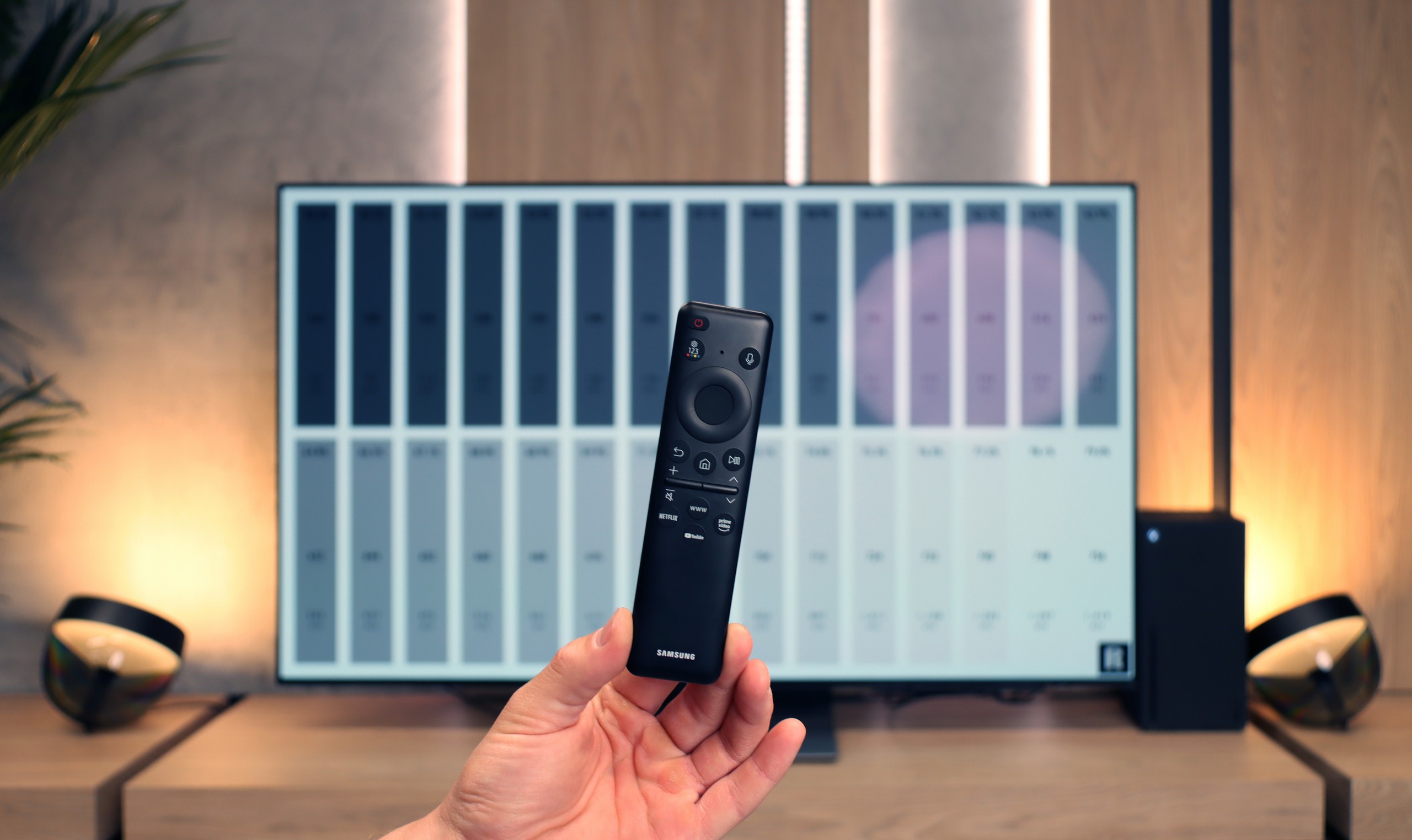
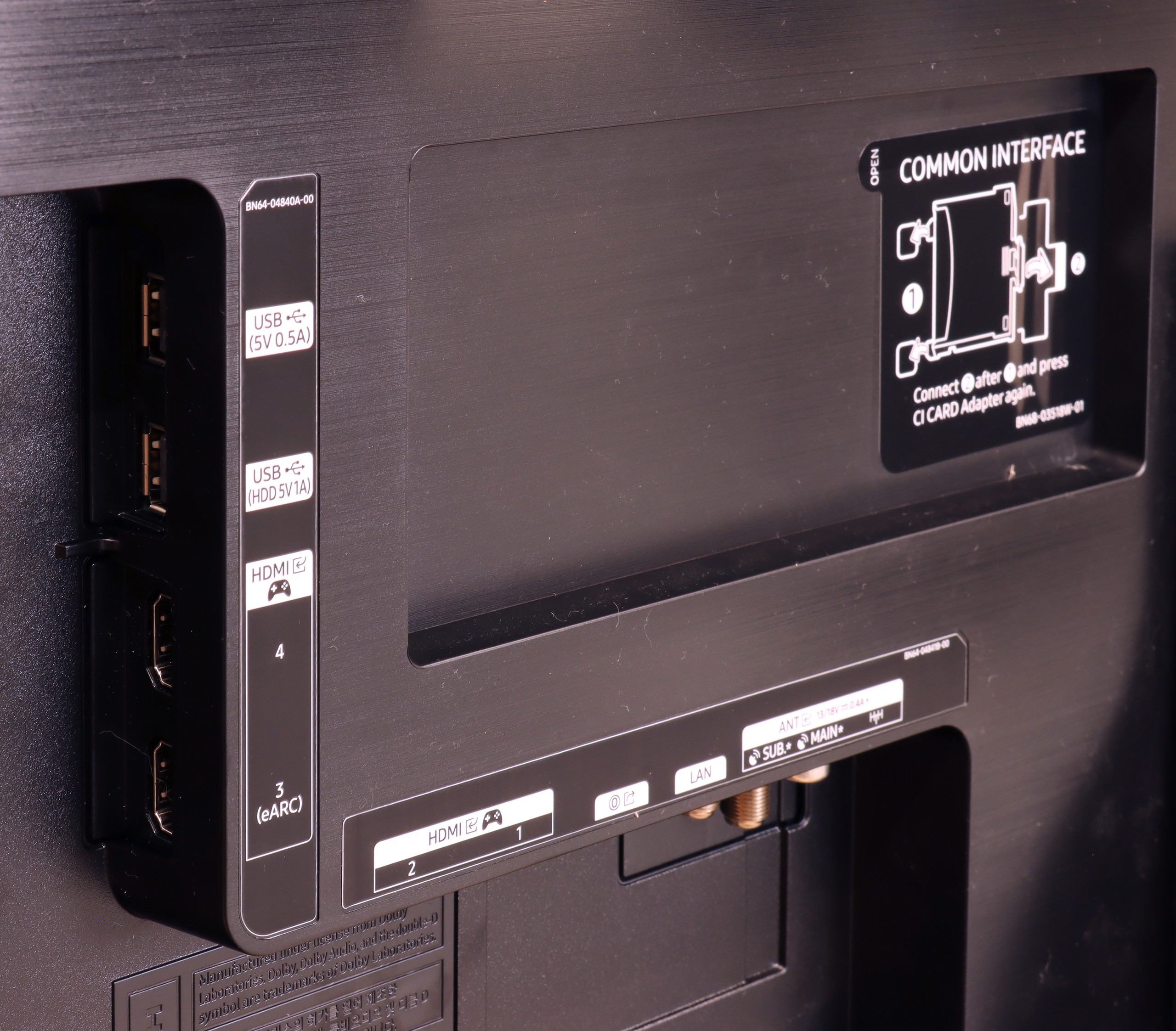
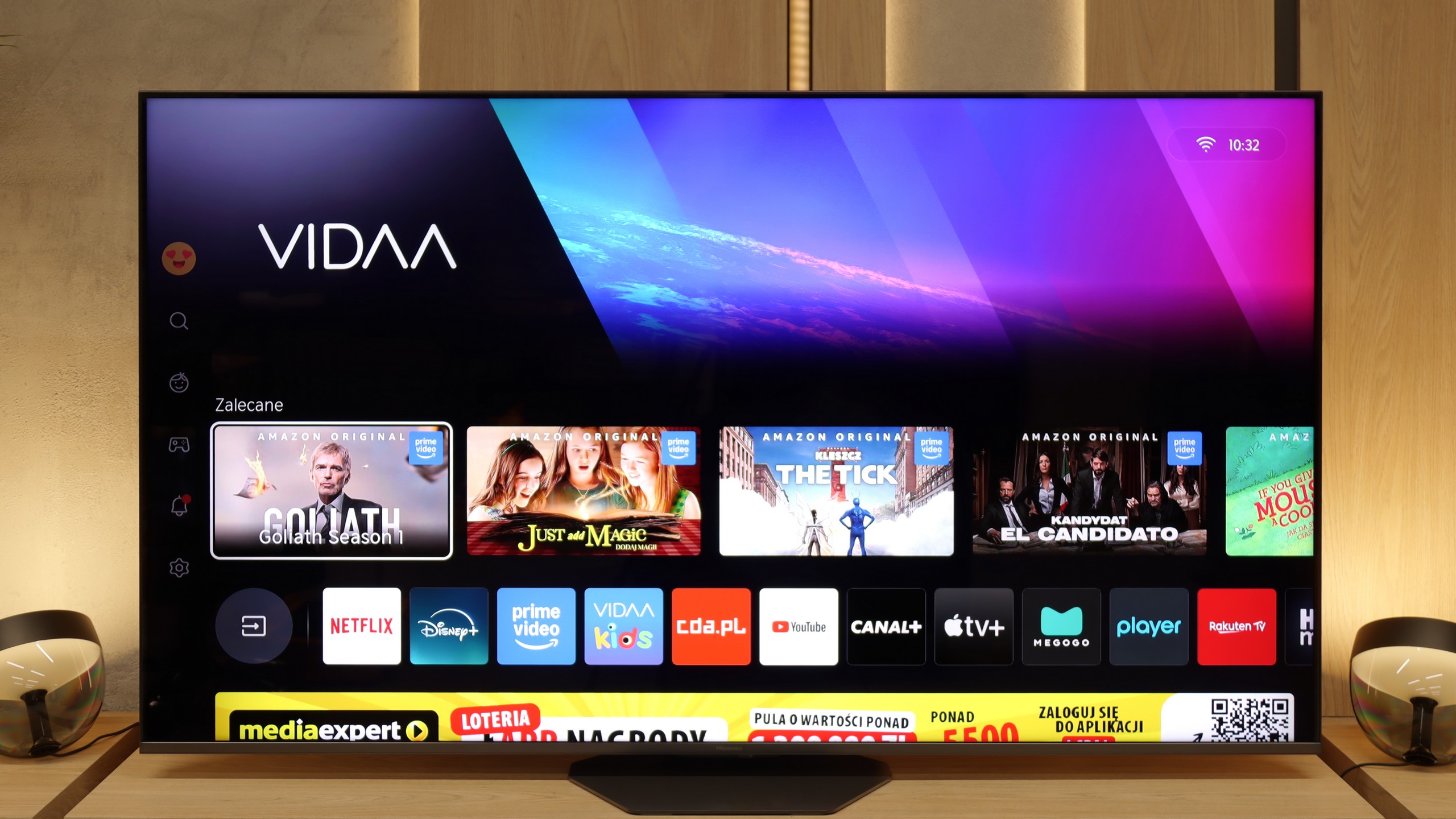
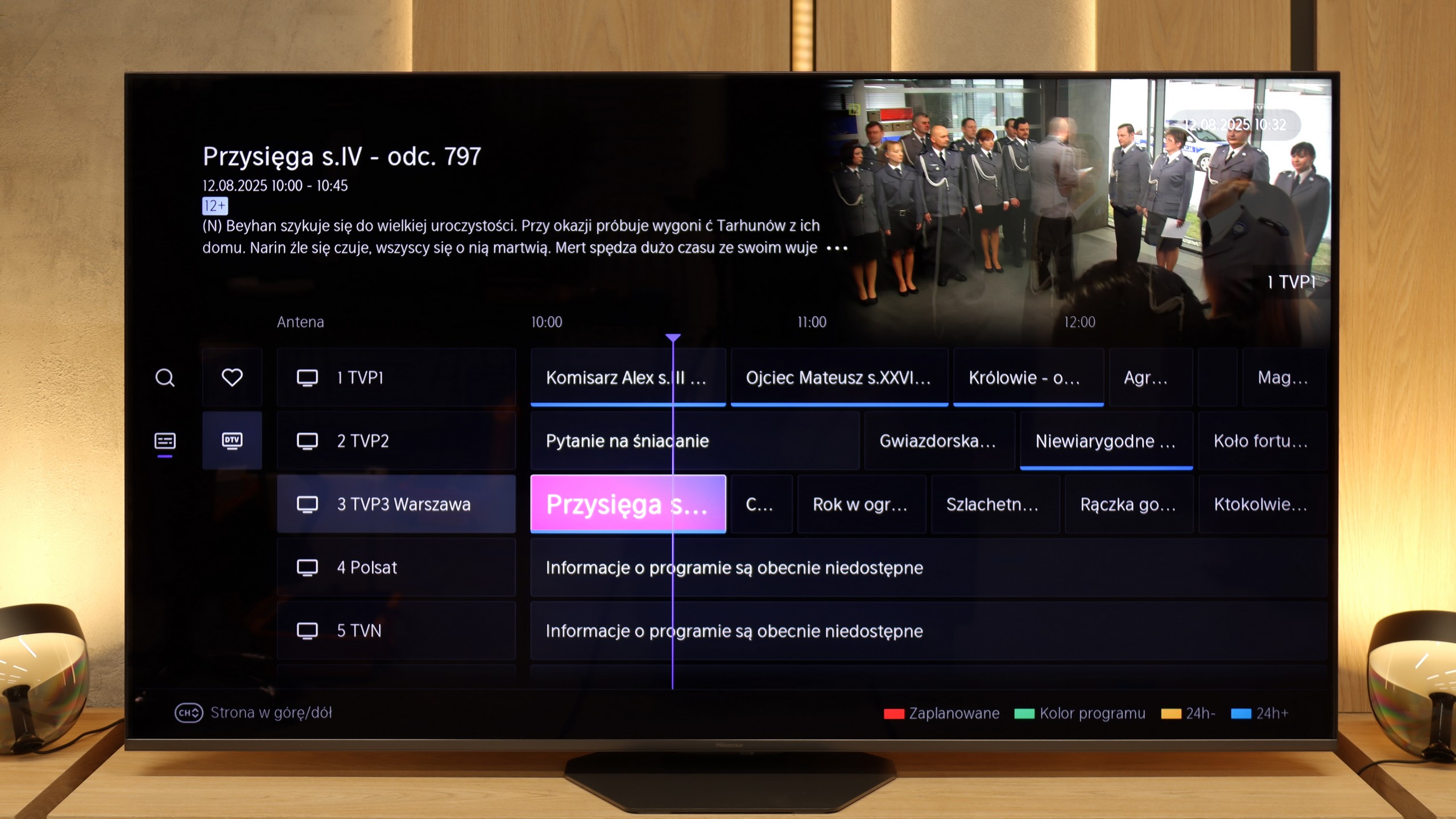
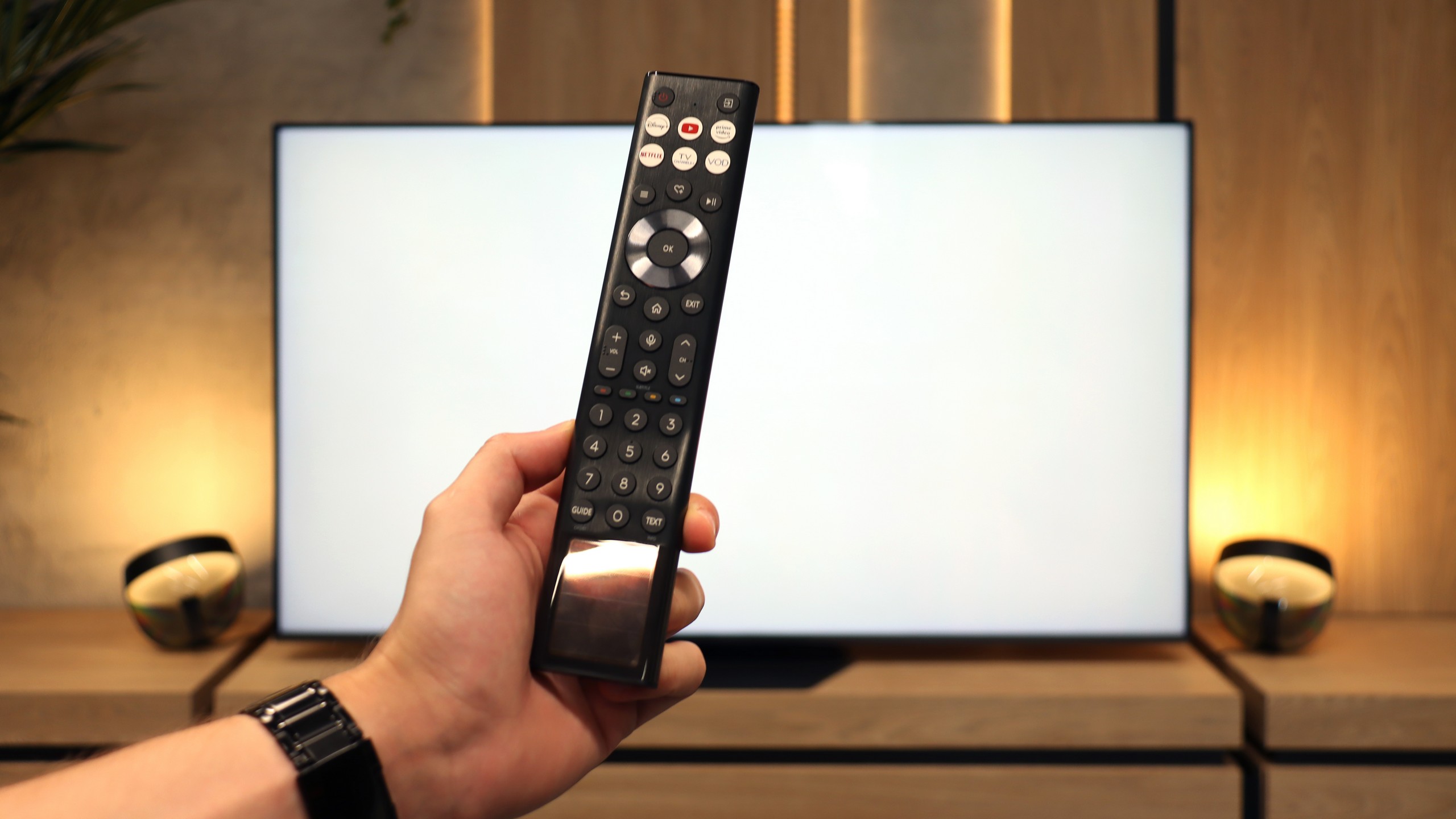
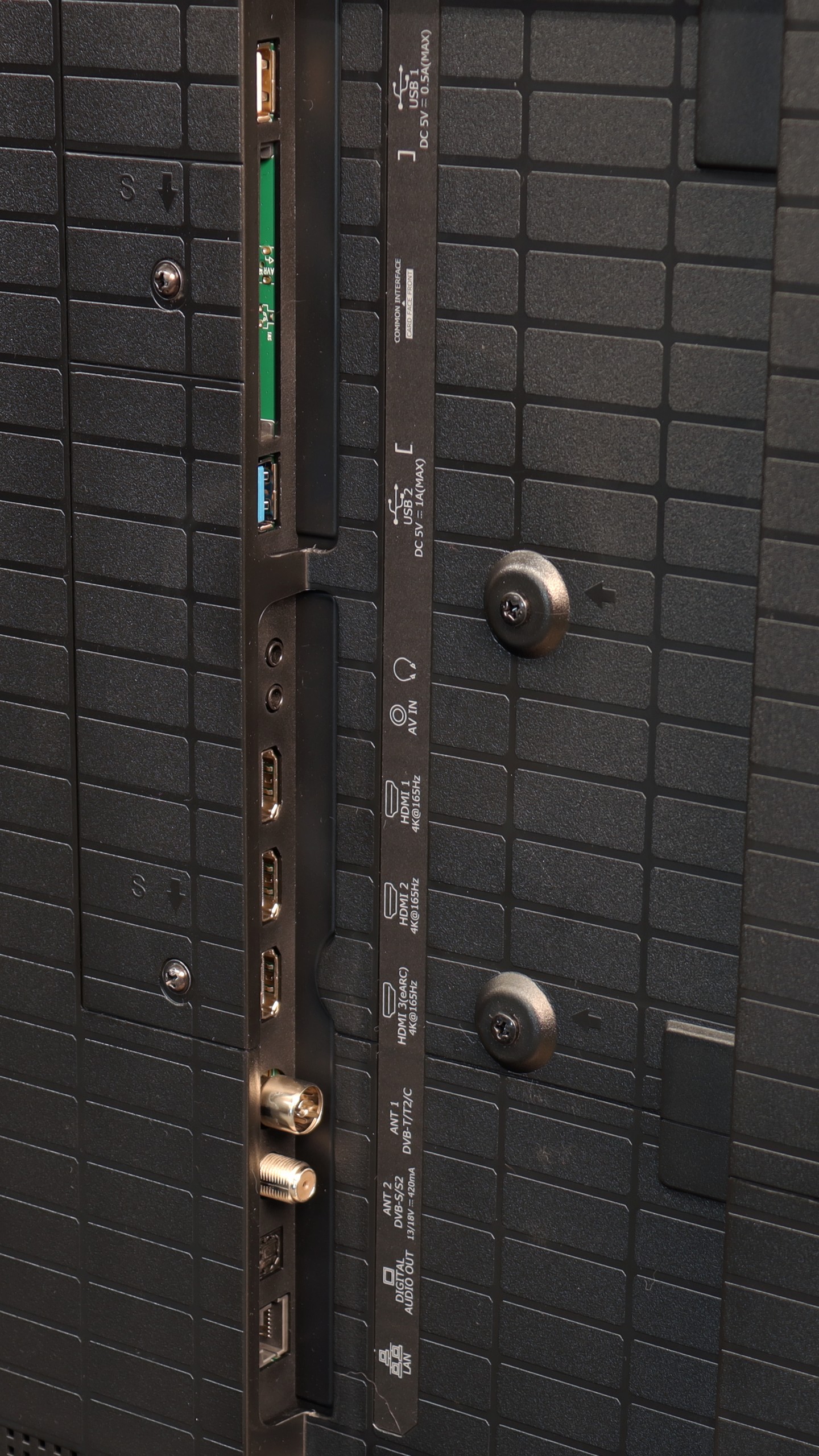
Samsung S90F is equipped with a range of classic TV features, such as EPG, CI module, and headphone support, but there’s also more to it. Thanks to the presence of several tuners, the TV offers a picture-in-picture (PiP) function – very useful, for example, when we are watching one match but want to check the score of another match happening simultaneously. It's a pity that Samsung has completely abandoned the USB recording feature for some time now, but this is partially compensated by good integration with decoders and other devices. The remote – while small and lacking a numeric keypad – allows you to control multiple devices connected to the TV. You can easily manage a decoder, amplifier, console, or other gear with it – all without needing to reach for several remotes.
As for the Smart TV system – Tizen on the S90F operates very smoothly, which is not a given in cheaper models with this system. The system itself is extensive and offers plenty of features – we have screen mirroring, AirPlay, Bluetooth device support, and quite a few options related to smart home functionality, such as controlling bulbs or other smart devices directly from the TV. However, it’s important to remember that Tizen is a closed system, so when it comes to apps – we are limited to what we find in the Samsung store. And while it is quite extensive, it doesn’t match the flexibility of the Google TV platform. It’s worth keeping this in mind if you have specific needs for niche applications.
Classic Features
Hisense U8Q runs on the VIDAA system, which can still be considered a newcomer in the European market, but it must be acknowledged – the manufacturer really has a lot to offer here. You'll find classic features that many people still find useful: USB recording, a clear EPG guide, and the ability to connect wired headphones, which will be particularly appreciated by seniors. A nice addition is the presence of an audio jack – a connection that is slowly disappearing from televisions, but has been retained here.
USB-C in the TV!
A new feature in the U8Q is the USB-C port with DisplayPort support. This is a non-standard but very practical solution – it allows you to connect a laptop or phone with a single cable, even if those devices don't have an HDMI output.
Smart Features: VIDAA
When it comes to smart features, VIDAA operates smoothly. The interface is fast, apps open without significant delays, and network functions – such as screen mirroring or AirPlay – work very well. Sure, there are some minor shortcomings, but these are more details than real problems. The Achilles' heel remains the somewhat limited app library. However, it's worth remembering that the list of available programs can change from day to day – some disappear, others appear, so the situation may improve.
Playing files from USB
8/10
8.3/10
Supported photo formats:
Maximum photo resolution:
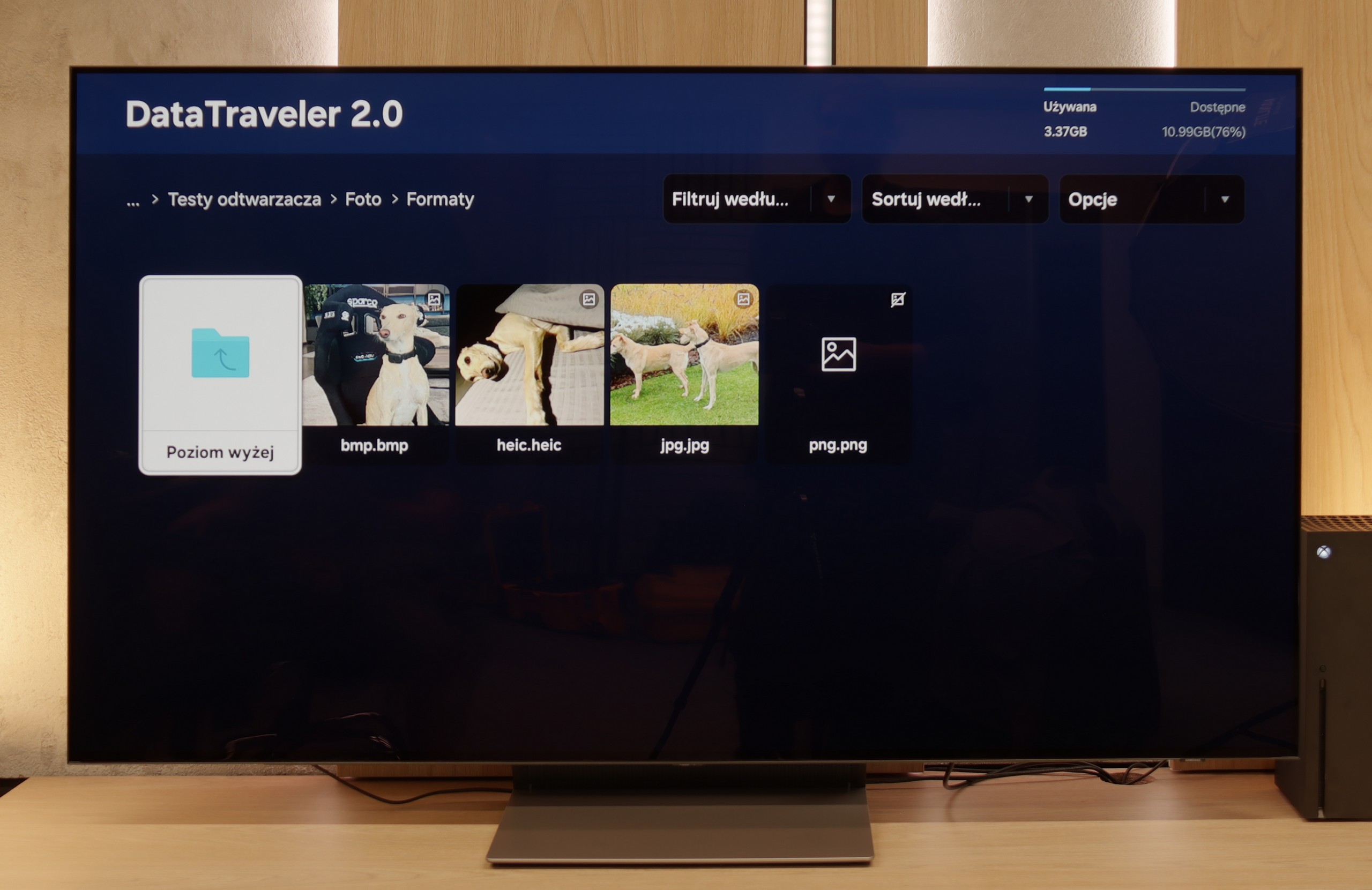
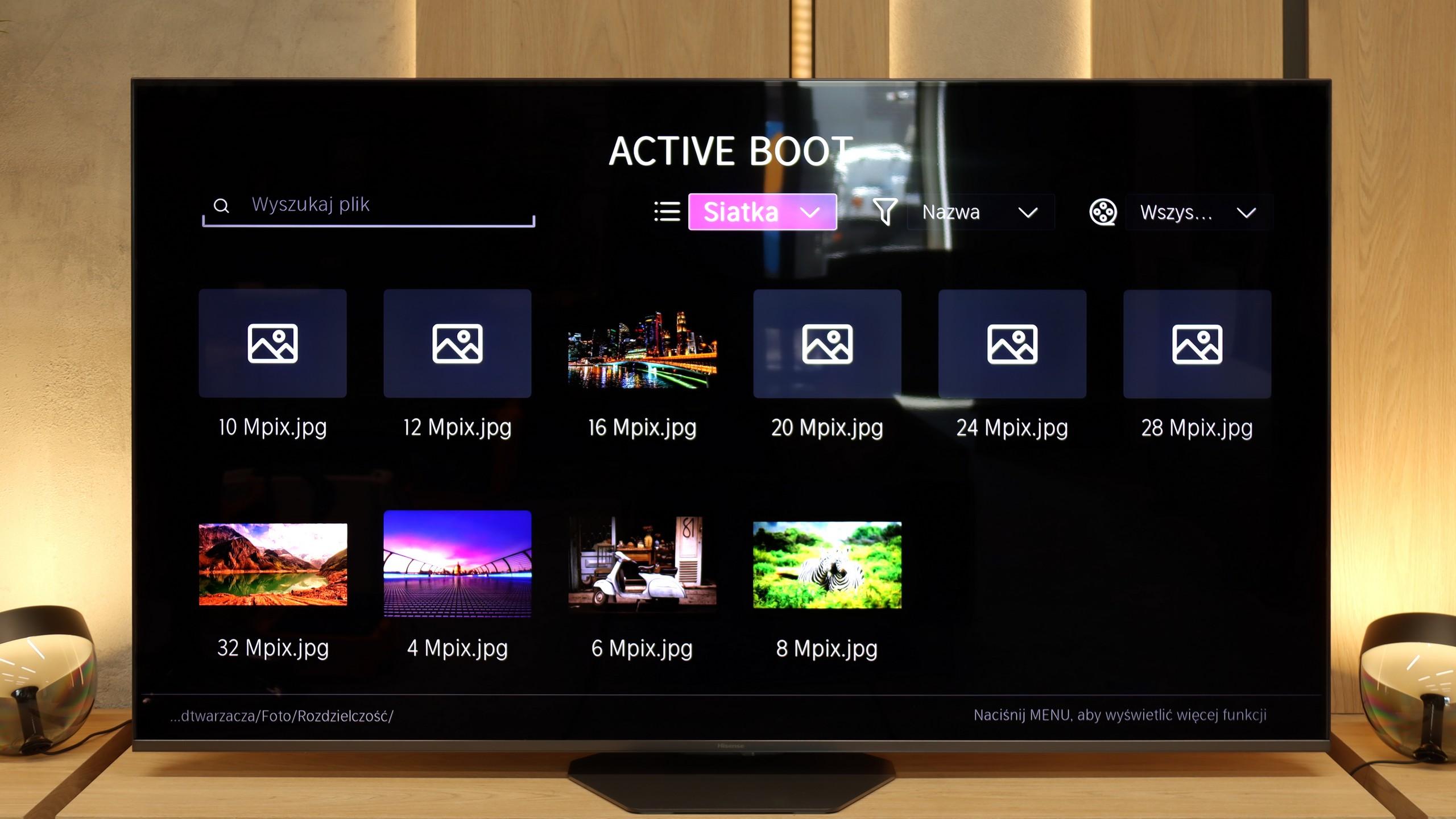
The built-in media player in the S90F is alright and supports quite a few popular formats. Unfortunately, during testing – once again – we encountered issues, despite the manufacturer's claims. The television did not play some formats that are supposedly supported, such as HEIC photos (Apple's version), or SRT and SUB subtitle files. In everyday use for most people, such a player will be sufficient to play a movie from a USB drive, but it’s worth keeping in mind that surprises may occur. Perhaps the situation will be improved in future updates, but at the time of writing this review – it works as it works.
The built-in media player in the Hisense U8Q will be completely sufficient for most people. The television opens popular video and audio formats and also handles photos. However, there is a small caveat – not all photo resolutions are supported. Therefore, if we have photographs saved in a very high number of megapixels, they may simply not open. It’s worth bearing this in mind to avoid unpleasant surprises during the family photo show.
Apps
8.7/10
7.7/10














































Sound
7.4/10
7.8/10
- Subjective sound quality:7.4/107.8/10
- Dolby Digital Plus 7.1:
- Dolby True HD 7.1:
- Dolby Atmos in Dolby Digital Plus (JOC):
- Dolby Atmos in Dolby True HD:
- DTS:X in DTS-HD MA:
- DTS-HD Master Audio:
The S90F plays really quite nicely, with noticeable bass and pretty good dynamics. A definite plus is the support for Dolby Atmos, which allows the TV to sound a bit more “spatial” – of course, as much as the built-in 2.1 set allows 😉. Unfortunately, as is often the case with Samsung, it lacks support for the DTS:X format. So, if you want to take advantage of its capabilities, you'll need to connect your audio equipment directly to the amplifier, rather than to the TV itself – otherwise, it just won't work.
The Hisense U8Q performs really well in terms of sound. The audio is pleasant, with a slight bass and quite decent mid tones, so it’s perfectly adequate for everyday viewing of movies, series, or gaming.
It does get a bit worse when we crank the volume up to 100%. That’s a rather rare scenario, but it’s worth mentioning. With very strong bass, the rear speakers start to work so intensely that the TV can slightly “rattle,” and the sound takes on an unpleasant, plastic echo. Therefore, it’s best to keep the volume between 70–80% – at that level, the U8Q sounds clear and enjoyable, without any unwanted effects.


